June 30, 2008
MOZART: Così fan tutte — Salzburg 2004
Music composed by Wolfgang Amadeus Mozart (1756–1791). Libretto by Lorenzo Da Ponte.
First Performance: 26 January 1790, Burgtheater, Vienna.
| Principal Characters: | |
| Fiordiligi, a lady from Ferrara, living in Naples | Soprano |
| Dorabella, sister of Fiordiligi | Soprano |
| Guglielmo, an officer, Fiordiligi’s lover | Bass |
| Ferrando, an officer, Dorabella’s lover | Tenor |
| Despina, maidservant to the sisters | Soprano |
| Don Alfonso, an old philosopher | Bass |
Setting: 18th Century Naples
Synopsis:
Act I
It is early morning. Two young officers, Ferrando and Guglielmo, boast about the beauty and virtue of their sweethearts, the sisters Dorabella and Fiordiligi (“La mia Dorabella”). Don Alfonso, an older man and a friend of the two officers, insists that a woman's constancy is like the Arabian phoenix - everyone says it exists but no one has ever seen it (“È la fede delle femmine”). He proposes a wager of one hundred sequins that if they give him one day, and do everything he asks, he will prove the sisters are like all other women - fickle. The two young men willingly agree to Alfonso's terms and imagine with pleasure how they will spend their winnings (“Una bella serenata”).
Fiordiligi and Dorabella gaze blissfully at their miniature portraits of Guglielmo and Ferrando (“Ah, guarda sorella”), and imagine happily that they will soon be married. Alfonso's plan for the day begins when he arrives with terrible news: the young officers have been called away to their regiment. The two men appear, apparently heartbroken, and they all make elaborate farewells (“Sento, o dio”). As the soldiers leave, the two women and Alfonso wish them a safe journey (“Soave sia il vento”). Alfonso is delighted with his plot and feels certain of winning his wager.
As Despina complains about how much work she has to do around the house, Fiordiligi and Dorabella, upset by the departure of their fiancés, burst in. Dorabella vents her feelings (“Smanie implacabili”), but Despina's advice is to forget their old lovers with the help of new ones. All men are fickle, she says, and unworthy of a woman's fidelity (“In uomini, in soldati”). Her mistresses resent Despina's approach to love, and depart. Alfonso arrives to plan the next stage of his wager: he enlists Despina's help to introduce the girls to two exotic visitors, in fact Ferrando and Guglielmo in disguise, and is relieved when Despina does not recognize the two men. The sisters are scandalized to discover strange men in their house. The newcomers declare their admiration for the ladies, each wooing the other's girlfriend, according to Alfonso's design, but the girls reject them. Fiordiligi likens her constancy to a rock in a storm (“Come scoglio”). The men are confident of winning the bet, but Alfonso reminds them that the day is still young. Ferrando reiterates his passion for Dorabella (“Un'aura amorosa”), and the two go off to await Alfonso's further orders. Despina, still unaware of the men's identities, plans the afternoon with Alfonso.
As the sisters lament the absence of their lovers, the two “foreigners" stagger in, pretending to have poisoned themselves in despair over their rejection. The sisters call for Despina, who urges them to care for the men while she and Alfonso fetch a doctor. Despina re-enters disguised as a doctor and, with a special magnet, pretends to draw off the poison. She then demands that the girls nurse the patients as they recover. The men revive (“Dove son?”), and request kisses. As Fiordiligi and Dorabella waver under renewed protestations of love, the men begin to worry.
Act II
In the afternoon, Despina lectures her mistresses on their stubbornness and describes how a woman should handle men (“Una donna a quindici anni”). Dorabella is persuaded that there could be no harm in a little flirtation, and surprisingly, Fiordiligi agrees. They decide who will pair off with whom, and fitting perfectly into Alfonso's plan, each picks the other's original suitor (“Prenderò quel brunettino”).
Alfonso has arranged a romantic serenade for the sisters in the garden, and after delivering a short lesson in courtship, he and Despina leave the four young people together. Guglielmo, courting Dorabella, succeeds in replacing her portrait of Ferrando with a golden heart (“Il core vi dono”). Ferrando apparently has less luck with Fiordiligi (“Ah, lo veggio”); but when she is left alone, she guiltily admits he has touched her heart (“Per pietà”).
When they compare notes later, Ferrando is certain that they have won the wager. Guglielmo, although pleased at the report of Fiordiligi's faithfulness to him, is uncertain how to break the news of Dorabella's inconstancy to Ferrando. He shows his friend the portrait he took from Dorabella and Ferrando is furious. Guglielmo blames it all on women (“Donne mie, la fate a tanti!”), but his friend is not comforted (“Tradito, schernito”). Guglielmo asks Alfonso to pay him his half of the winnings, but Alfonso reminds him again that the day is not yet over.
Fiordiligi rebukes Dorabella for being fickle, but finally admits that in her heart she has succumbed to the stranger. Dorabella coaxes her to give way completely, saying love is a thief who rewards those who obey him and punishes all others (“È amore un ladroncello”). Left alone, Fiordiligi decides to run away and join Guglielmo at war, but Ferrando, pursuing the wager, tries one last time to seduce her and succeeds.
Guglielmo is furious, but Alfonso counsels forgiveness: that's the way women are, he claims, and a man who has been deceived can blame only himself (“Tutti accusan le donne”). As night falls, he promises to find a solution to their problems: he plans a double-wedding.
Despina runs in with a double-wedding plan of her own: the two sisters have agreed to marry the “foreigners,” and she is to find a notary for the ceremony. The scene is set for the marriage, and Alfonso arrives with the notary - Despina in another disguise. As Fiordiligi and Dorabella sign the contract, martial strains herald the return of the former lovers' regiment. In panic the two women hide their intended husbands and try to compose themselves for the arrival of Ferrando and Guglielmo. The two apparently joyful soldiers return, but soon become disturbed by the obvious discomfort of the ladies. When they discover the notary the sisters beg the two men to kill them. Ferrando and Guglielmo reveal to them the identities of the "foreigners.” Despina realizes that Alfonso had let her in on only half of the charade and tries to escape. Alfonso bids the lovers learn their lesson and, with a hymn to reason and enlightenment, the day comes to a close.
Commentary.
“Così has been seen as revealing a dark side to the Enlightenment, an anti-feminist sadism (Ford 1991). Yet by any showing the most admirable character is Fiordiligi. The girls develop more than the men. Dorabella at least learns to understand her own lightness; and ‘Fra gli amplessi’ suggests that Fiordiligi has matured through learning the power of sexuality. There is little sign that Guglielmo learns anything in the school for lovers, even that those who set traps deserve to get caught, although his vanity is wounded as deeply as his purse. Ferrando, however, comes to live as intensely as Fiordiligi, and may appear to have fallen in love with her. To suggest that they should marry (leaving Guglielmo for Dorabella) is, however, still less satisfactory than reversion to the original pairings. The conclusion represents not a solution but a way of bringing the action to a close with an artificiality so evident that no happy outcome can be predicted. The music creates this enigma, but cannot solve it.”
Julian Rushton: 'Così fan tutte', Grove Music Online (Accessed 11 June 2006).
Click here for complete libretto.
image=http://www.operatoday.com/cosi_salzburg_2004.png image_description=Cast of Così fan tutte, Salzburg 2004 (Photo: Bernd Uhlig) audio=yes first_audio_name=Wolfgang Amadeus Mozart: Così fan tutte first_audio_link=http://www.operatoday.com/Cosi2.m3u product=yes product_title=Wolfgang Amadeus Mozart: Così fan tutte product_by=Fiordiligi (Tamar Iveri)Dorabella (Elina Garanca)
Despina (Helen Donath)
Ferrando (Saimir Pirgu)
Guglielmo (Nicola Ulivieri)
Don Alfonso (Thomas Allen).
Wiener Philharmoniker, Wiener Staatsopernchor, Philippe Jordan (cond.).
Live performance, 30 July 2004, Großes Festspielhaus, Salzburg
June 23, 2008
Aldeburgh Festival, Snape Maltings, Suffolk
 By Martin Hoyle [Financial Times, 23 June 2008]
By Martin Hoyle [Financial Times, 23 June 2008]
Last Thursday György Kurtág and his wife Márta played pieces from his piano collection Játékok on the sonically upholstered upright with its almost woolly sound now favoured by the composer, making his often spiky fragments into the musical equivalent of comfort food.
Correcting a Mozart Deficit
 How To Get a Speedy, Remedial Introduction to the Composer
How To Get a Speedy, Remedial Introduction to the Composer
By PIA CATTON [NY Sun, 23 June 2008]
When you really don't know something, it's best just to admit it. And earlier this year, an embarrassing fact emerged: I didn't know Mozart's music as well as I thought I did. The catalyst for this admission came while at the barre during a ballet class. My teacher bellowed, in that way that only ballet teachers can, "Feel the music. This is Mozart."
Soprano Dessay makes a stunning S.F. debut in 'Lucia'
 (Photo by Terrence McCarthy)
(Photo by Terrence McCarthy)
By Richard Scheinin [Mercury News, 19 June 2008]
Through the decades, the touchstone role of Lucia in Donizetti's "Lucia di Lammermoor" has been sung in San Francisco by Lily Pons, Joan Sutherland, Beverly Sills and other luminary sopranos. It's time to add Natalie Dessay to the list.
Don Carlo at Royal Opera House
Almost as soon as the 2007/08 season’s details had been published, Angela Gheorghiu decided that the role of Elisabetta di Valois was not for her after all and left Covent Garden’s casting department the challenge of finding a suitable replacement. Soon afterwards Rolando Villazón, the star Mexican tenor destined for the role of Carlo, took a sabbatical on medical advice and cancelled a clutch of international engagements including his planned appearance as Nemorino in the Royal Opera’s L’elisir d’amore.
Anyhow, Villazón returned from his break, the company engaged its former Young Artist Marina Poplavskaya as Elisabetta, the production sold out as soon as it went on sale, and everything appeared to bode well.
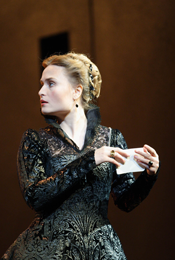 Marina Poplavskaya as Elisabetta
Marina Poplavskaya as Elisabetta
On the evidence of this opening night, Villazón is not yet back to full vocal health. When he is on form, he delivers some thrillingly ardent singing, but elsewhere he is frustratingly inconsistent with cracked notes and intonation problems. The Fontainebleau scene was shoddily sung to the extent that it was tempting to leave at the first interval. And Villazón’s nervy, angsty dramatic interpretation had a tendency to reduce the young prince’s struggles with forbidden love and conflicting political duties to the petty tantrums of a moody adolescent.
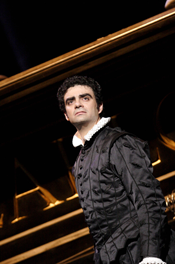 Rolando Villazón as Don Carlo
Rolando Villazón as Don Carlo
Poplavskaya is potentially a great talent (as evidenced by her outstanding Rachel in last season’s concert performance of La Juive) but sadly the role of Elisabetta di Valois is really beyond her, at least for now. The absence of a full Italianate lirico-spinto tone is perhaps not the end of the world, but her obvious vocal fatigue towards the end of the performance presents a serious problem in a role whose major aria takes place in the final scene. The paleness of her pearly, ‘covered’ soprano is matched by an onstage persona that is far too much the ice maiden, even in the opening scene where we should surely be able to see the spark of youth and vitality that has so captivated the impetuously youthful Carlo.
My comments thus far have perhaps made the whole effort sound disastrous. Fortunately this was not the case. As Posa, Simon Keenlyside gave a world-class performance; human, honest and noble. Ferruccio Furlanetto’s brittle Filippo and Eric Halfvarson’s terrifying Grand Inquisitor each exuded such gravitas of presence that their confrontation was truly gripping. The bells and oppressive Catholic glitz of the auto-da-fé scene packed a real punch, with special praise due to the chorus, while conductor Antonio Pappano seems to have the measure of the piece.
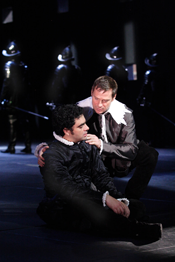 Roland Villazón (Don Carlo) and Simon Keenlyside (Rodrigo)
Roland Villazón (Don Carlo) and Simon Keenlyside (Rodrigo)
Sonia Ganassi’s Eboli was decently-sung in a superficial sort of way, with a big personality and lots of showy fireworks, but her voice and her portrayal seemed to lack an emotional centre. Like Villazón and Poplavskaya, her voice seems a size too small.
The production bears many of Hytner’s hallmarks: uncomplicated situations and character interactions in front of handsome sets in colours evoking the time and place of the setting. The intricate detail used in the individual flats and costumes of Bob Crowley’s designs never takes away from the sense of an elegant visual simplicity. The snow-covered forest of Fontainebleau has a particularly elegant beauty. It is a good-looking, solid staging, and eminently revivable; it seems churlish to complain that it plays things rather safe. Hytner got some boos from the stalls on opening night, which was quite baffling — there were none of the usual triggers which incite audiences to dislike a new production so vehemently.
Ruth Elleson © 2008
image=http://www.operatoday.com/Villazon_Poplavsaya.png image_description=Rolando Villazón (Don Carlo) and Marina Poplavskaya (Elisabetta) in Don Carlo at ROH product=yes product_title=Giuseppe Verdi: Don Carlo product_by= Don Carlo (Rolando Villazón), Elisabetta di Valois (Marina Poplavskaya), Rodrigo (Dimitris Tiliakos/Simon Keenlyside), Philip II (Ferruccio Furlanetto), Princess Eboli (Sonia Ganassi), Tebaldo (Paula Murrihy/Pumeza Matshikiza), Conte di Lerma (Nikola Matišic), Flemish Deputies (Jacques Imbrailo/Krzysztof Szumanski/Kostas Smoriginas/Daniel Grice/Darren Jeffery/Vuyani Mlinde), Grand Inquisitor (Eric Halfvarson), Monk (Robert Lloyd), Voice from Heaven (Anita Watson). Conductor Antonio Pappano. Director Nicholas Hytner. Designs Bob Crowley. Lighting Mark Henderson.Performance of 6 June 2008. product_id=Above: Rolando Villazón (Don Carlo) and Marina Poplavskaya (Elisabetta) in Don Carlo at ROH
All photos by Catherine Ashmore courtesy of Royal Opera House
Don Giovanni. No, the other one
It was composed to a typical buffo libretto by Giovanni Bertati, his collaborator on twenty farces, in Venice in February 1787, where its success inspired someone to send the score to Lorenzo da Ponte in Vienna. He rewrote and expanded the piece, borrowing many of Bertati’s ideas, and gave it to Mozart, who presented his version at Prague’s Tyl Theater on October 29.
One goes to hear Gazzaniga’s Giovanni for foretaste, a prediction, a glimpse of the glory soon to come — a hint of Mozart’s inspiration — but there is little sign of it. The piece opens with an attempted rape and a murder all right, there is a catalogue aria (someone has altered the numbers! Aha!), a peasant wedding, a statue invited to dinner, a ghostly return. There are many moments when you expect to be stunned, enlightened, exalted, shocked, as Mozart’s opera does even on the twentieth hearing — but Gazzaniga keeps missing the chance to startle, to amaze, to create wonder. Donna Anna has the perfect moment for an aria of vengeance when she finds her father’s body (or a duet of vengeance, as in Mozart), but in Gazzaniga … she simply departs, never to return. Don Giovanni has many moments for a seduction duet, but it does not enter his brainless tenor head. Elvira’s last entreaty for Giovanni’s repentance is not an outburst — it’s a full-length aria at a moment when the drama should be snap, snap, snap. The statue’s return sends no cold shivers — the experience of the afterlife has not transformed his vocal manner, as Mozart felt it should. And, having heard Mozart, we know he was right.
It is impossible not to make such comparisons, but it is most unfair to Gazzaniga, and to an evening pleasantly spent. There are lovely tunes in this opera, justifying a long and successful career (51 operas, all but this one forgotten), some elegant ideas, and … a lot that fizzles. With pretty voices, it is a delicious way to pass ninety minutes — ideally by candlelight in a baroque garden theater. (A remodeled warehouse in Toronto’s Distillery District will do in a pinch, and the acoustics are ace.) Gazzaniga was good but ordinary; attending his opera reminds one that Mozart was … extraordinary.
The most effective music, it seemed to me, was the scene of the peasant wedding: the chorus had a Spanish style to it that Mozart did not bother with, and the arias of Biagio (infuriated at his wayward girlfriend) and Maturina (the girl in question, who is falling for the tall, handsome stranger) were very fine and sung by the finest voices in the company, Canadian Opera’s Studio (i.e., their young artists’ program). Justin Welsh, a baritone of energy and smooth production, made the most of Biagio, who has rather more presence in this version — da Ponte and Mozart rightly abbreviated his protest in order not to interrupt the rush of the drama. Gazzaniga gives him a full da capo, and Welsh sang it beautifully — but it interrupts. Maturina was Lisa DiMaria, a sweet, clear, luscious soprano who will mature (no pun intended) into a splendid Susanna and Zerlina in a very short time. I look forward to hearing both of them again.
The other singers, all young, healthy and good actors, did not seem quite so polished, so ready for the major leagues. Jon-Paul Décosse had the most to do as the servant, Pasquariello — he opens the show (just as Leporello does) and sings the catalogue, and serves as his master’s foil in the tomb and dinner scenes. His baritone is strong and supple, but his vigorous antics — sometimes humorous, sometimes menacing — will make him a particular asset to the livelier school of buffo staging. Melinda Delorme, afflicted with a wig that would alienate any lover, made a poignant and energetic Donna Elvira — in this opera the unchallenged prima donna, with two ornamented arias and a comic duet in which she and Maturina fight over “their” man, who of course has set them on each other while he pursues another lady entirely. (That duet’s an idea Bertati might have stolen from Act I of Mozart’s Figaro, but it was probably a buffo staple.) The Commendatore of Andrew Stewart looked gaunt and (as a statue) immobile, but did not succeed in creating shivers where Gazzaniga had neglected to provide them in the score. Michael Barrett (Ottavio) and Adam Luther (Giovanni), the two tenors, sounded uncomfortable with the style of the music, forceful where they should have been graceful, sensuous, ardent. They bit off the ends of notes that should drift into the aether. I suspect both are aiming for nineteenth-century tenor roles, and I applaud that ambition, but precise vocal control always comes in handy.
The production by Tom Diamond was basic and clear, with one annoying, pointless touch: Instead of nobly killing the Commendatore face to face, Don Giovanni sneaked up behind him and stabbed him in the back. This did not suit the story or the personality of our antihero. A consort of nine musicians played the score — undoubtedly it would sound grander with a full orchestra, but the subtle touches of Mozart’s version would still not have been there.
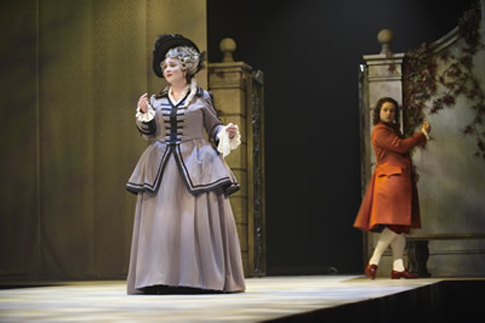 Melinda Delorme as Donna Elvira and Adam Luther as Don Giovanni in the COC’s Ensemble Studio production of Don Giovanni. Photo © 2008 Michael Cooper
Melinda Delorme as Donna Elvira and Adam Luther as Don Giovanni in the COC’s Ensemble Studio production of Don Giovanni. Photo © 2008 Michael Cooper
The second half of this double bill — for a rather larger band of musicians, tackling a self-consciously brilliant score with aplomb — was Stravinsky’s brief retelling of a couple of farmyard folktales, Renard, composed for the Paris salon of his buddy Princess de Polignac — that’s Winnaretta Singer, the sewing machine heiress, to you. The piece was not meant to be staged, merely sung by a quartet of male singers — but Mr. Diamond could not resist. His production derived from World Wide Wrestling matches (the witty costumes were by Yannik Larivée), and no doubt I missed a lot of in-jokes, but the four hammy singers hurled themselves joyously into it. (No limbs were broken — but it was close.) They sang well, too, in clearly pronounced English — again, I especially enjoyed tiny Mr. Welsh, but the standard was high across the board.
John Yohalem
image=http://www.operatoday.com/dong01.png image_description=Andrew Stewart as Il Commendatore and Yannick-Muriel Noah as Donna Anna in the COC’s Ensemble Studio production of Don Giovanni. Photo © 2008 Michael Cooper product=yes product_title=Giuseppe Gazzaniga: Don GiovanniIgor Stravinsky: Renard product_by=Don Giovanni: Don Giovanni (Adam Luther), Donna Anna (Lisa DiMaria / Yannick-Muriel Noah), Donna Elvira (Betty Allison / Melinda Delorme), Donna Ximena (Erin Fisher / Betty Allison), Il Commendatore (Andrew Stewart), Duca Ottavio (Michael Barrett), Maturina (Teiya Kasahara / Lisa DiMaria), Pasquariello (Jon-Paul Décosse / Alexander Hajek / Justin Welsh), Biagio (Justin Welsh), Lanterna (Michael Barrett). Conductor Steven Philcox. Director Tom Diamond. Set and Costume Designer Yannik Larivée. Lighting Designer Bonnie Beecher.
Renard: Tenor 1 (Adam Luther), Tenor 2 (Michael Barrett), Baritone 1 (Justin Welsh / Alexander Hajek), Baritone 2 (Andrew Stewart). Conductor Derek Bate. Director Serge Bennathan. Set and Costume Designer Yannik Larivée. Lighting Designer Bonnie Beecher.
Canadian Opera company Ensemble Studio Production, performance of June 16. product_id=Above: Andrew Stewart as Il Commendatore and Yannick-Muriel Noah as Donna Anna in the COC’s Ensemble Studio production of Don Giovanni.
Photo © 2008 Michael Cooper
June 22, 2008
MEYERBEER: Semiramide
The opera comes from Meyerbeer's early years, before he established himself in France and created his greatest successes (an opening booklet note from Sergio Segalini refers to Meyerbeer in those years as a "Wandering Jew," believe it or not).
The plot of Semiramide mixes palace intrigue with various forms of transvestism, which would seem to be a good recipe for a success on today's stages. Meyerbeer's score finds him in faux-Rossini mode, with the recitatives accompanied by a rather drab piano, perfunctorily played. Ensembles and arias intertwine in typical patterns, and Meyerbeer's melodic gift presents itself as more a promise than accomplishment. However, act two has some attractive numbers, including a sweet aria for princess Tamiri called "D'un genio che m'accende," which Stefania Grasso sings just well enough to allow for an appreciation of the music. The writing for the tenor role, Ircano, pushes the Rossini touch into early Verdi territory, and Aldo Caputo delivers the role with pleasing force and adequate agility. Not a major voice, but an appealing one.
However, in the title role, and with quite a lot of music, Clara Polito will be a trial for many ears, although there are always fans out there with an appreciation for warbly, acidic vocalizing. Polito's intonation suffers in her first numbers. Later she settles, and she has the technique to satisfy some of Meyerbeer's challengers. In the end, and allowing for taste, Polito's instrument simply lacks enough appeal to give her character's music a real chance to impress.
Dynamic, as usual, recorded a live performance. For the most part stage noise does not intervene. In tiny print on the rear of the CD case Dynamic lists the place and location of the recording as the Palazzo Ducale, Martina Franca, in August 2005. Rani Calderon leads the orchestra Internazionale D'Italia and the Slovak Choir of Bratislava. Cnsidering the rarity of the work, the musicians do an adequate, if characterless, job.
Meyerbeer fans surely will want to have this set. Others will have to decide how much interest they have in early Meyerbeer to accept a performance of modest accomplishment.
Chris Mullins
image=http://www.operatoday.com/Meyerbeer_Semiramide.png
image_description=Giacomo Meyerbeer: Semiramide
product=yes
product_title=Giacomo Meyerbeer: Semiramide
product_by=Clara Polito; Aldo Caputo; Eufemia Tufano; Federico Sacchi; Stefania Grasso; Roberto De Biasio. Slovak Choir of Bratislava/Pavol Prochazka. Orchestra Internazionale D’Italia/Rani Calderon. Recorded at Palazzo Ducale, Martina Franca, Italy, August 2006
product_id=Dynamic 533/1-2 [2CDs]
price=$39.99
product_url=http://www.arkivmusic.com/classical/Drilldown?name_id1=8097&name_role1=1&comp_id=209927&genre=33&bcorder=195&label_id=287
MOZART: Die Zauberflöte — Salzburg 2006
Music composed by W. A. Mozart. Libretto by Emanuel Schikaneder.
First Performance: 30 September 1791, Theater auf der Wieden, Vienna
| Principal Characters: | |
| Sarastro Priest of the Sun | Bass |
| Tamino a Javanese Prince | Tenor |
| An Elderly Priest [‘Sprecher’; Orator, Speaker] | Bass |
| Three Priests | Bass, Tenor, Spoken Role |
| The Queen of Night | Soprano |
| Pamina her daughter | Soprano |
| Three Ladies attendants to the Queen | Two Sopranos, Mezzo-Soprano |
| Three Boys | Two Sopranos, Mezzo-Soprano |
| Papagena | Soprano |
| Papageno a birdcatcher, employed by the Queen | Baritone |
| Monostatos a Moor, overseer at the Temple | Tenor |
| Two Men in Armour | Tenor, Bass |
| Three Slaves | Spoken Role |
Synopsis:
Act I
Scene 1. Among rocky mountains
Pursued by a serpent which he is unable to kill because he has run out of arrows, Prince Tamino faints. Three veiled ladies kill the serpent and fall in love with the handsome stranger, each wishing to stay with him while the others tell their queen what has happened. Eventually all go. A feather-clad, pipe-playing figure arrives: Papageno the bird catcher, who claims to have killed the serpent. The three ladies padlock his mouth to stop him telling more lies. They give Tamino a portrait of Pamina, daughter of the Queen of the Night and when he falls in love with it, they tell him she has been carried off by an evil demon called Sarastro and he swears to save her.
A clap of thunder heralds the arrival of the queen, who promises that her daughter shall be Tamino’s bride if he rescues her. The ladies remove Papageno’s padlock and give Tamino a flute to help him in his quest and, ordering Papageno to go with him, give him a set of bells to use in time of need, explaining that three spirits will guide Tamino to Sarastro’s domain.
Scene 2. A room in Sarastro’s palace
Pamina tries to escape from the advances of the moor Monostatos, who is supposed to be guarding her. She faints and Papageno appears. He and Monostatos take each other for the devil and Monostatos flees. Papageno tells Pamina about the handsome prince who has fallen in love with her and is coming to rescue her and she consoles him on his wifeless state with the assurance that a loving heart will surely find a partner.
Scene 3. Pillars leading to the temples of wisdom, reason and nature
The three spirits leave Tamino in front of the pillars. He is turned back by unseen voices as he tries to enter the first two temples and a priestly figure bars his way to the third. From this man, the speaker, Tamino learns that although Pamina is in Sarastro’s realm, things are not as the Queen of the Night has represented them. But Tamino is not yet fit to understand the mysteries of the temples where Sarastro rules in wisdom. The Speaker disappears, but the voices tell Tamino that Pamina is alive. He expresses his joy by playing the flute and animals gather round to listen. He hears Papageno’s pipes and sets off to find him. Meanwhile Papageno and Pamina have been following the sound of the flute. They are overtaken by Monostatos and slaves who are about to drag them off in chains when Papageno remembers his magic bells. Monostatos and the slaves dance off, forgetting their intention.
Sarastro and priests of the brotherhood arrive and Pamina tells him that she has tried to escape because of Monostatos. Sarastro is kind, but tells her that she cannot yet be set free because of her mother’s evil influence.
Monostatos has captured Tamino. Pamina and Tamino rush into each other’s arms. Sarastro orders that Monostatos be whipped and Tamino and Papageno be led into the temple to be purified.
Act II
Scene 1. A grove in Sarastro’s domain
Sarastro urges the brotherhood to allow Tamino to undergo the trials that will make him worthy to join their band, explaining that the gods have ordained Pamina as Tamino’s wife; it is for this reason that he took her from her mother, whose aim is to destroy the temple.
Scene 2. A temple courtyard at night
Two priests ask Tamino and Papageno if they are prepared to undergo the trials. Tamino is ready. Papageno demurs, but weakens when told that the gods have a wife in store for him, just like himself and called Papagena. The priests impose silence on them, warn them against the wiles of women and leave them in the dark. The three ladies appear and threaten vengeance, but Tamino ignores them, advising Papageno to do the same. The ladies are driven off by the brotherhood. The priests commend Tamino for his steadfastness and lead him and the reluctant Papageno off to the next trial.
Scene 3. A garden lit by the moon
Monostatos tries to kiss the sleeping Pamina, but is frightened off by the arrival of the Queen of the Night, who gives Pamina a dagger, ordering her to kill Sarastro and bring back to her the circle of the sun which had been given to Sarastro by her late husband. When Pamina expresses her revulsion at the though of killing, Monostatos tells her that she can only save herself and her mother by loving him. Sarastro drives him away and assures Pamina that her mother is safe from him, since no thoughts of vengeance are permitted in his realm.
Scene 4. A hall
Tamino and Papageno are led in by the priests and left alone. Papageno complains of thirst and an old woman gives him water, tells him he is her sweetheart and disappears. The spirits bring back Tamino’s flute and Papageno’s bells, which had been taken from them. They also bring a feast which Papageno attacks with gusto, while Tamino abstains, playing the flute instead.
The sound draws Pamina, who is distressed when Tamino refuses to speak to her. Even Papageno, his mouth full of food, does not answer. She longs for death.
Scene 5. A subterranean vault
The priests rejoice at Tamino’s progress. Sarastro tells Tamino and Pamina to bid each other farewell for ever. Papageno is rejected by the brotherhood, but replies that there are more of his kind than theirs in the world. All he wants is a wife. The old woman appears; and, when he reluctantly promises to be faithful, changes into a young and beautiful girl, Papagena. But she is taken away by the priests.
Scene 6. A garden
The three spirits stop Pamina from killing herself, assuring her that Tamino would be heartbroken; they offer to take her to him.
Scene 7. Two mountains, one spitting fire, the other with a waterfall
Two men in armor guard the approaches. They tell Tamino that he may now speak to Pamina, and together they undergo the ordeals of fire and water, Tamino playing the flute as they go.
Scene 8. A garden
The boys prevent Papageno from committing suicide in his despair at the loss of Papagena. Following their advice, he plays his magic bells and she appears. They make joyful plans for a philoprogenitive future.
Scene 9. An underground vault
The Queen of the Night, her ladies and Monostatos, who has joined them in the hope of getting Pamina, attack the temple but are repulsed and defeated.
Scene 10. The temple of the sun
Sarastro leads the brotherhood in celebration of the triumph of light, and Tamino and Pamina are united in marriage.
[Synopsis Source: Opera~Opera]
Click here for the complete libretto.
image=http://www.operatoday.com/Zauberflote_Salzburg_2006.png image_description=Genia Kühmeier (Pamina), Diana Damrau (Königin der Nacht) [Photo: Salzburger Festspiele] audio=yes first_audio_name=W. A. Mozart: Die Zauberflöte first_audio_link=http://www.operatoday.com/zauberflote2.m3u product=yes product_title=W. A. Mozart: Die Zauberflöte product_by=René Pape (Sarastro)Paul Groves (Tamino)
Genia Kühmeier (Pamina)
Christian Gerhaher (Papageno)
Irina Bespalovaite (Papagena)
Diana Damrau (Queen of the Night)
Franz Grundheber (Speaker/First Priest)
Inga Kalna (First Lady)
Karine Deshayes (Second Lady)
Ekaterina Gubanova (Third Lady)
Members of the Vienna Boys' Choir (Three Boys )
Xavier Mas (Second Priest)
Michael Autenrieth (Third Priest)
Burkhard Ulrich (Monostatos)
Simon O'Neill (First Armed Man)
Peter Loehle (Second Armed Man)
Konzertvereinigung Wiener Staatsopernchor
Wiener Philharmoniker
Riccardo Muti (cond.)
Live performance, 29 July 2006, Großes Festspielhaus, Salzburg
A rare treasure in Saint Louis. . .
Although Cosa rara’s eponymous rare treasure concerns the honesty of a beautiful woman, Opera Theatre surely enjoyed the play on words in presenting this rarely performed but once-treasured opera. The company has successfully contextualized Mozart in its last few seasons by presenting works of his contemporaries, including Grétry’s Beauty and the Beast (1771) and Cimarosa’s The Secret Marriage (1792). Vincent Martín y Soler’s opera continues this trend, since nearly everything about Una cosa rara reminds us of its more familiar Mozartian brethren.
Born in Spain two years before Mozart, Martín lacked his contemporary’s astonishing precocity, though by his early twenties he had composed comic operas for many important Italian towns. He moved to Vienna in 1785, four years after Mozart’s own arrival. The following year each man composed an opera for Emperor Joseph II’s Italian theater. Mozart inaugurated his partnership with librettist Lorenzo da Ponte, culminating in Le nozze di Figaro. Martín likewise collaborated with da Ponte on his comic opera, Una cosa rara. Figaro’s modest success in May 1786 was overshadowed by Una cosa rara’s triumphant debut eight months later. In October 1787 Martín penned a follow-up hit with the immensely popular pastoral work L’arbore di Diana. Less than a month later, Don Giovanni opened in Prague. In it, Mozart acknowledged his peer’s popularity by quoting a tune from Cosa rara during the Act II dinner entertainment. These textual and musical links to Mozart are not just historical happenstance, but structurally important in Cosa rara. Da Ponte’s influence weighs heavily, with both the plot and the characters echoing Figaro and Così fan tutte. Although Martín’s musical style lacks the spice of Mozart at his best, Cosa rara is perfectly passable as good 18th century opera. For us just as for the Viennese, Martín’s pleasant pastoral ditties digest easily.
Stage director Chas Rader-Schieber conceived Opera Theatre’s Cosa rara as a farcical world of warped whimsy, albeit with a rather friendly touch. His vision was amply fulfilled by the aforementioned sheep on wheels, pink flamingos, garden gnomes, etc. These flamingos extended beyond mere props, even decorating the outdoor gardens at intermission. The set and the costumes seemed to get as much or more attention than the music, since each character’s entrance was accompanied by applause or laughter. The costumes continued to get more and more outlandish, culminating in the high (or low?) point of the Queen’s Act II hunting outfit, which featured giant pink glittering antlers affixed to her head. It was all extremely silly, but the cast (and audience by extension) seemed to have a ball.
Although the visual spectacle of this production dominated at times, the vocal performances were solid as well, with some truly excellent moments. Soprano Mary Wilson was both impressive and endearing as the dotty Queen of Spain, and she certainly seemed to enjoy her silly onstage shenanigans. She wowed the audience during many of her numbers, particularly the virtuoso rondo in Act II. A great example of Cosa rara’s more elevated musical style for the noble characters, Wilson nailed the difficult technical passages in this aria with finesse and good taste in ornamentation. Her son the Prince was interpreted in a delightfully hammy manner by tenor Alek Schrader. With his over the top pink and black sequined costume, his platinum blond wig a cross between Madame Pompadour and rockabilly à la Jerry Lee Lewis, Schrader titillated the audience throughout. His difficult Act II recitative and aria was very nicely sung, although perhaps one might desire a little more power in the finish. Corrado’s part, sung by Paul Appleby, was much less substantial, with only short solos.
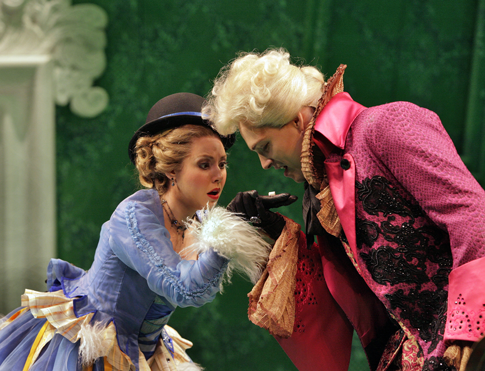 Maureen McKay and Alek Schrader
Maureen McKay and Alek Schrader
On to the peasants! Soprano Maureen McKay was absolutely delightful as the ingenuous shepherdess Lilla, and had the audience in stitches from her first entrance, running frantically onto stage and literally throwing herself at the Queen’s feet. Though this particular performance had a few isolated strained notes in the higher register, McKay has a lovely clear voice, and her perfect acting really helped make the production. Lilla’s lover Lubino, a rather dimwitted impetuous shepherd, was well-served by Keith Phares’ rich baritone voice and excellent diction. Phares particularly amused the audience with his ridiculous Act I parody of a vengeance aria. If Lilla and Lubino represent the perfect shepherd couple, their counterparts Ghita and Tita offer (still more) comic relief. Ghita was saucily interpreted by soprano Kiera Duffy, while Matthew Burns took the bass role of Tita. The two bickered impressively, interspersing their arguments with hilarious make-out sessions. Both singers had some of the more difficult patter singing in Cosa rara, which they managed with aplomb. Matthew Burns’s voice was especially impressive, as was his stellar diction.
The orchestra members, drawn from the Saint Louis Symphony Orchestra, were well conducted by Corrado Rovaris. They performed the 18th century style cleanly and followed the singers sensitively, with the only minor shortcoming being the occasional trampling of forte-piano alternations.
Hugh Macdonald’s new English singing translation certainly added to the hilarity of it all. He clearly reveled in fashioning silly rhymes such as mooning and spooning and swooning, and even alerted the audience to the arrival of the melody famously quoted in Don Giovanni. His new translation played a major role in the successfully slapstick comedy of this Cosa rara, cramming in jokes, puns, wink-wink references, and general silliness by the handful.
Opera Theatre’s rare treasure in this performance seemed to lie not in the revitalization of some forgotten masterpiece, but in presenting an opera completely without pretensions, a perfectly frivolous summer treat.
Erin Brooks © 2008
image=http://www.operatoday.com/Cosa_rara01.png image_description=Mary Wilson as Queen Isabella (Photo by Ken Howard courtesy of Opera Theatre of Saint Louis) product=yes product_title=Vincent Martín y Soler: Una cosa rara o sia Belleza ed onestá [A Rare Treasure, or Beauty and Honesty] product_by=Queen Isabella (Mary Wilson); Prince Giovanni (Alek Schrader); Corrado, (Paul Appleby); Lilla (Maureen McKay); Lubino (Keith Phares); Tita (Matthew Burns); Ghita (Kiera Duffy); Lisargo (David Kravitz). Musicians of the Saint Louis Symphony, conducted by Corrado Rovaris. Directed by Chas Rader-Shieber, with sets by David Zinn and costumes by Clint Ramos. product_id=Above: Mary Wilson as Queen IsabellaAll photos by Ken Howard courtesy of Opera Theatre of Saint Louis
Choral Music by Dvořák and Brahms
Yet his Requiem, Op. 89, which received its premiere in 1891, is an equally find work that deserves a similar kind of popularity. While stated explicitly with reference to Brahms’ Deutsches Requiem all Requiems are, ultimately for the living, and the approach each composer has taken in setting the text of this rite also reflects something of the intended audience of the piece.
Composers in the nineteenth century approached the Requiem Mass in various ways, from the dramatic setting by Berlioz to the more personal expression of the sentiments of the rite by Brahms in his Deutsches Requiem. Dvorak treated the Requiem in a more conventional manner by using the text of the Requiem Mass associated with the Catholic liturgy, an idiom that should be familiar to the audience he addressed. While it bows to convention, such adherence to tradition should not suggest anything mundane. On the contrary, Dvorak’s setting bears attention for the way in which he expressed this text in one of the finer scores of his artistic maturity. A work for four vocal soloists, chorus, and orchestra, it is a powerful large-scale work that brings to mind some of the composer’s symphonic music, while simultaneously relying on choral sonorities for some of its more poignant effects. As occurs in Dvorak’s later symphonies, the interplay of textures is an important aspect of the score, which is as colorful as some of the composer’s operas.
The second section, the Gradual in which the text reiterates the prayer for peace (“Requiem aeternam dona eis, Domine, / Et lux perpetua luceat eis. / In memoria aeterna erit justis / ab auditione mala non timebit.”) the juxtaposition of the soprano solo with the chorus is memorable, especially in the context of the sometimes transparent orchestration. Likewise, the Dies irae that follows involves the traditional melodic formulation associated with the chant and also the exploits the thunderous sound of percussion and brass. In contrast to the relentless trumpets of Verdi’s well-known Requiem, the softer, more subdued sonorities that Dvorak used in his setting create a different, more intimate effect. In contrast to the terrors at the prospect of divine judgment, the listener gains a sense of consolation and the prospect of eternal peace. In these and other ways, Dvorak approached the Requiem with the same sense for building on tradition as he did in his symphonic works. The result is a score that deserves to be heard more often, not only on recordings, but also in live performances.
This recording of Dvorak’s Requiem preserves a performance given on 13 November 2005 at a concert given in the memory of Grand Duke Adolf of Luxemburg (also Duke of Nassau), and the quality of the effort is apparent from the outset. The solo parts are sung by Mechthild Bach (soprano), Stefanie Irányi (alto), Markus Schäfer (tenor), and Klaus Mertens (bass). Mertens is, perhaps, the most familiar soloist, also performs Brahms’ Vier ernste Gesänge on this recording. He is balanced well by Schäfer, whose ringing sound captures well the solo line for the tenor. Mechthild Bach brings some fine touches to the soprano part, which involves some sustained passages that demand an accomplished winder. Likewise, Stefanie Iránji works well with Bach and other soloists when the concertato-like sonorities contrast the full chorus throughout much of the work.
Even with a less extensive discography than that which exists for the Stabat Mater, Dvorak’s Requiem is available in several fine performances, and this particular performance can be counted among the notable ones. The sound on this particular Hänssler recording is, perhaps, a bit close and, as a result, does not always allow for the full sonorities of chorus or the combined chorus and orchestra to have the ambiance that would emerge in the actual hall. While not completely dry, it lacks the resonance one would associate with Dvorak. Even so, the sound is quite crisp and captures well the clearly articulated texts. The diction of the soloists is matched by the similarly precise entrances of the entire chorus, which Doris Hagel leads masterfully.
This recording includes on the second disc a performance of Brahms’ Vier ernste Gesänge by Klaus Mertens. Since the length of Dvorak’s Requiem forces a recording onto two CDs, the inclusion of this late work by Brahms is quite welcome, especially since it involves Mertens, whose performance in Dvorak’s Requiem is impressive. A cycle of settings for solo voice, the four songs have texts from the Old and New Testament that deal, in a sense, with the last things, that is, those enduring points of contemplation regarding existence, love, and salvation. Neither a Requiem, per se, nor funereal in tone, the Vier ernste Gesänge from 1896, the year before its composer died, are nonetheless reflective in nature, and Mertens’ interpretation captures that sense well. His resonant voice and fine diction are essential to the quality of this recording.
James L. Zychowicz
image=http://www.operatoday.com/Dvorak_Brahms_Requiems.png
image_description=Antonin Dvorak: Requiem, Op. 89; Johannes Brahms: Vier erste Gesänge, Op. 121
product=yes
product_title=Antonin Dvorak: Requiem, Op. 89; Johannes Brahms: Vier erste Gesänge, Op. 121
product_by=Mechthild Bach, soprano, Stefanie Irányi, alto, Markus Schäfer, tenor, Klaus Mertens, bass. Kantorei der Schlosskirch Weilburg, Capella Weilburgensis, Doris Hegel, conductor
product_id=Profil Medien PH06050 [2CDs]
price=$34.99
product_url=http://www.arkivmusic.com/classical/Drilldown?name_id1=3313&name_role1=1&comp_id=58859&genre=43&bcorder=195&label_id=5269
June 19, 2008
Mozart and Lortzing from Hamburg Opera on film
Cinematography, hair, costumes: all are redolent of a proud stage tradition adapted - not always with subtlety - to the needs of the camera, circa 1970. In 2008, what might have seemed hopelessly dated, even musty, actually carries a sort of "toy world" appeal.
The chief drawback of most filmed opera, especially from this era, is that the intimacy and varied perspective of the camera cannot mitigate the artificiality of the sound, which not only relies on lip syncing but also maintains a consistently flat audio stage, belying the naturalistic movements of the both camera and actors. To the credit of both the Lortzing and Mozart sets, excellent conductors lead energetic performances from the Hamburg Philharmonic State Orchestra. Charles Mackerras deals with Lortzing's perky - perhaps excessively perky - score to the comic Zar und Zimmerman with flair and good spirits. An entire opera based on a series of mistaken identities (Peter the Great has gone "undercover" to learn more about the world), Zar und Zimmerman has never really established itself outside of its home country. This video doesn't exactly make one regret that fact, but it does offer an extremely attractive cast doing their best to make the time pass pleasantly. Lucia Popp's absolutely sweet Marie stands out, with Raymond Wolansky as Peter the Great right behind her. In the tenor role of Peter Ivanov, Peter Haage's chubby male ingenue may annoy some as much as he did your reviewer.
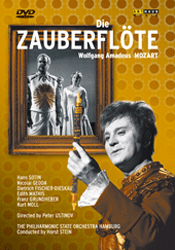 Hans Sotin has the comic villain role in the Lortzing, and he reappears in Die Zauberflöte as Sarastro. Veteran Horst Stein leads an old-fashioned performance, appropriately enough for this production, directed with a disappointingly scant amount of invention by Sir Peter Ustinov. The illustrious cast included Dietrich Fischer-Dieskau as the Speaker, Nicolai Gedda as Tamino, Edith Mathis as Pamina, Cristina Deutekom as the Queen of the night, and William Workman as Papageno. Their vocal contributions are all solid, but Ustinov fails to inspire them to offer more than perfunctory acting. Deutekom sings a fearsome Queen while her face remains entirely impassive. No one lip syncs all that well, but Workman in particular barely seems to be trying. The three boys compete to find pitch, with no winner. Monostatos appears in blackface. All in all, despite the camera, the opera remains stagebound and rarely shows sign of life.
Hans Sotin has the comic villain role in the Lortzing, and he reappears in Die Zauberflöte as Sarastro. Veteran Horst Stein leads an old-fashioned performance, appropriately enough for this production, directed with a disappointingly scant amount of invention by Sir Peter Ustinov. The illustrious cast included Dietrich Fischer-Dieskau as the Speaker, Nicolai Gedda as Tamino, Edith Mathis as Pamina, Cristina Deutekom as the Queen of the night, and William Workman as Papageno. Their vocal contributions are all solid, but Ustinov fails to inspire them to offer more than perfunctory acting. Deutekom sings a fearsome Queen while her face remains entirely impassive. No one lip syncs all that well, but Workman in particular barely seems to be trying. The three boys compete to find pitch, with no winner. Monostatos appears in blackface. All in all, despite the camera, the opera remains stagebound and rarely shows sign of life.
The Lortzing DVD preserves a charming performance of an opera little known in the US, so it is worth a look. Fine DVDs of Die Zauberflöte, however, can easily be acquired, so anyone thinking of this set should either be a fan of the cast or a devotee of mediocre TV direction.
Chris Mullins
image=http://www.operatoday.com/Lortzing.png image_description=Albert Lortzing: Zar und Zimmermann product=yes product_title=Albert Lortzing: Zar und Zimmermann product_by=Peter the Great (Raymond Wolansky), Peter Ivanov (Peter Haage), Van Bett (Hans Sotin), Marie (Lucia Popp), Admiral Lefort (Herbert Fliether), Lord Syndham (Noël Mangin), Marquis de Châteauneuf (Horst Wilhelm), Widow Browe (Ursula Boese), Officer (Franz Grundheber). Ballet and Chorus of the Hamburg State Opera, The Philharmonic State Orchestra Hamburg, Charles Mackerras, conductor. product_id=Arthaus Musik 101269 [DVD] price=$29.98 product_url=http://www.arkivmusic.com/classical/Drilldown?name_id1=7315&name_role1=1&comp_id=197478&bcorder=15&label_id=4357Karajan opera highlights on Classics for Pleasure
The Cosi fan Tutte is the well-regarded 1954 set, in dry, flat mono. In its 72 minutes, the highlights favor act one and the first two scenes of act two. Most of the opera's most beloved music does come in these sections, but any sense of the dramatic resolution gets lost in the quick jump to the supposedly joyous final ensemble.
Is it just the faded quality of the mono sound that makes it difficult for your reviewer to find the sparkle and charm that the performance promises? Elisabeth Schwarzkopf sings with style and accuracy, but little warmth. Nan Merriman's Dorabella makes the most of her act one solo, "Smanie implacabili," infusing her reading with an edge of anger reminiscent of Donna Elvira. After that, she slips into the ensembles and loses any profile. Rolando Panerai and Leopold Simoneau, as the two lover/soldiers, sound appropriately fresh. Not much of Sesto Bruscantini's Don Alfonso can be heard, which may explain the lack of dramatic impetus. Ultimately, Karajan seems to have gotten the note-perfect performance he wanted, but the lack of edge tends to make the numbers run together.
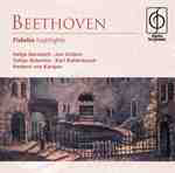 The 1971 Fidelio finds Karajan urging on the drama. The strings cut through impatiently, horns ring out with emphatic despair. But every moment seems to come in its own little interpretive capsule, unconnected to the next. Jon Vickers, who had already offered a remarkable Florestan on the famed Klemperer set, may be acting when he lets his voice sound worn at times, or it may be the singer coping with Karajan's sometimes languid tempo. Helga Dernesch faces a similar challenge in the rhythmically fragmented "Abscheulicher!" solo. She relies more on lungpower than interpretation, but that also has its merits. The rest of the cast makes little impression, although Karl Ridderbusch makes Rocco less annoying than the character can be.
The 1971 Fidelio finds Karajan urging on the drama. The strings cut through impatiently, horns ring out with emphatic despair. But every moment seems to come in its own little interpretive capsule, unconnected to the next. Jon Vickers, who had already offered a remarkable Florestan on the famed Klemperer set, may be acting when he lets his voice sound worn at times, or it may be the singer coping with Karajan's sometimes languid tempo. Helga Dernesch faces a similar challenge in the rhythmically fragmented "Abscheulicher!" solo. She relies more on lungpower than interpretation, but that also has its merits. The rest of the cast makes little impression, although Karl Ridderbusch makes Rocco less annoying than the character can be.
At an hour of music without dialogue, a Fidelio highlights set may be the way to go for some listeners, as it contains much of the opera's best music. Both this Fidelio and the Cosi certainly deserve acknowledgement as offering expert performances in many regards, but with strong competition from other sets for both operas, these two highlights CDs can best be recommended to die-hard fans of HvK.
Chris Mullins
image=http://www.operatoday.com/karajan_cosi.png image_description=Mozart: Così fan tutte (highlights) product=yes product_title=Mozart: Così fan tutte (highlights) product_by=Schwarzkopf, Merriman, Simoneau, Panerai, Otto, Bruscantini, Philharmonia Orchestra, Herbert von Karajan product_id=EMI Classics for Pleasure 393 3692 [CD] price=$7.99 product_url=http://www.arkivmusic.com/classical/Drilldown?name_id1=8429&name_role1=1&name_id2=56047&name_role2=3&label_id=1132&bcorder=361&comp_id=17374Discover forgotten operettas

The Ohio Light Opera reconstructs shows to their past splendor for 30th anniversary
By Elaine Guregian [Akron Beacon Journal, 19 June 2008]
One era's giant scandal is another era's forgotten memory.
Take, for example, the Mayerling Incident.
SF Opera scores a triumph
 [Photo by Terrence McCarthy courtesy of San Francisco Opera]
[Photo by Terrence McCarthy courtesy of San Francisco Opera]
by Jason Victor Serinus [Bay Area Reporter, 19 June 2008]
Ariodante's plot may have its giggle-inducing inanities, but its oft-florid music is glorious. Given the excellence of SFO General Director David Gockley's cast, we will be extremely fortunate to experience another equally glowing rendition of Handel's seldom-performed opera of 1735 in our lifetimes.
A Slimmed-Down Diva Keeps Her Vocal Heft
 By VIVIEN SCHWEITZER [NY Times, 18 June 2008]
By VIVIEN SCHWEITZER [NY Times, 18 June 2008]
LONDON — The drama following the 2004 dismissal of the soprano Deborah Voigt from a production of Strauss’s “Ariadne auf Naxos” at the Royal Opera House in Covent Garden here had many elements of the work itself: an opera within an opera that blends comic and tragic aspects and caricatures the lofty ideals of high art. Ms. Voigt’s dismissal, because she was too large to wear the cocktail dress stipulated by the director or adhere to his staging concepts, prompted an avalanche of international interest that ranged from buffa laughs about fat ladies singing to ponderous editorials about the meaning of “sacred art” versus Hollywood ideals of beauty.
June 17, 2008
A novel approach to modern opera
 Robin Usher [The Age, 17 June 2008]
Robin Usher [The Age, 17 June 2008]
LIKE many love affairs, Andrew Schulz's relationship with opera has its ups and downs. "I have mixed feelings about it and I become very frustrated at opera performances that are ossified and lack vitality," he says.
Early Music Festival Opens in the Key of DIY
 By Anne Midgette [Washington Post, 17 June 2008]
By Anne Midgette [Washington Post, 17 June 2008]
The early music movement has come a long way in terms of acceptance and understanding, but it still projects a sense of do-it-yourself. The Washington Early Music Festival, which opened its fourth season Sunday night, offers, in this spirit, a nice balance of professionalism and small-scale intimacy. On the one hand, it casts a spotlight on the breadth of early music that has grown up in this area in the last couple of decades -- all of the performers this season (which runs through June 28) are locally based. On the other, it still feels appealingly homemade.
Euro keeps scared music lovers from Vienna state opera
 [Earth Times, 17 June 2008]
[Earth Times, 17 June 2008]
Vienna - The Vienna State Opera recorded this season's lowest attendance rate during Austria's Euro 2008 match against Germany - because music lovers were scared by the nearby Euro fan zone, the opera said Tuesday. The opera filled only 79 per cent of its seats on the Monday match night, compared with an average of 99 per cent during the season.
Spivs, rockers and sopranos
 By Andrew Clark [Financial Times, 17 June 2008]
By Andrew Clark [Financial Times, 17 June 2008]
The test of any Ariadne, beyond the quality of singing, is whether it makes sense of the work’s inbuilt collisions – between vulgar comedy and high seriousness, idealism and pragmatism, modernist self-consciousness and old-world geniality, sincerity and hubris.
'Tosca' Time at the New York Philharmonic
 By JAY NORDLINGER [NY Sun, 16 June 2008]
By JAY NORDLINGER [NY Sun, 16 June 2008]
In these last weeks of the 2008-09 season, the New York Philharmonic is providing a night at the opera. They do this every once in a while — put on an opera-in-concert. The current offering is Puccini's "Tosca." And the Philharmonic will perform it twice more, tomorrow and Thursday nights.
June 15, 2008
Plácido Domingo’s miraculous autumn
The direction was self-managed by the singing company with very few “Italian-style rehearsals” (the pun is reportedly due to Plácido Domingo himself). Despite lacking costumes and props, the bodies kept moving and interacting throughout, so that, in the end, the chairs remained empty most of the time. The “Italian-style” label was also applicable to the tenor’s German diction, with consonants softened and vowels broadly open; probably more gracefully that any native singer would, yet not marring the text’s understanding. Other than a handful of specialists, actually, who really understands Wagner’s language? Ask any educated German for confirmation…
A 67-year-old Siegmund would make news anyway, but Domingo’s is simply a miracle for clarion tones, power and tenderness. This February at La Scala, where he sang the title-role in Alfano’s Cyrano de Bergerac, I had noticed his intelligence in overcoming the disadvantages of age through the frugal management of his resources until the final act. This was a different case, since Siegmund disappears after Act 2, so no such contrivances were needed and his stage charisma could deploy right from the start in a perfect combination of acting skills and velvety vocal color.
Nobly pathetic when retelling the mishaps of his family, he unsheathed sarcasm and proud challenge during his confrontations with Hundig, conjured delicate emotions in the hymn to Spring and warlike excitement in his appeal to the sword (“Nothung! Nothung!”) at the end of Act 1. Even Evelyn Herlitzius, a mercurial Brünnhilde of no particular firmness in her high tones, could not escape his manly spell during their duet on the battlefield in Act 2. With her beautiful central range, perfect intonation, and the coy passion of certain feminine motions, Waltraud Meier’s Sieglinde proved a worth partner for the hero; as a duly hateful Hundig, young René Pape could well abuse her with his marble bass, but could hardly shake her soft dignity.
Equally well matched (so to say) was the godlike couple in the Walhalla: Alan Held, the experienced Wagnerian from Washburn, Illinois, made an embittered but quite not unsympathetic Wotan, while Jane Henschel was a Fricka of inflexible decision and generous vocal means. In the patrol of Valkyries, Michelle Marie Cook (Gerhilde) and Gemma Coma-Alabert (Rossweisse) emerged for their burnished instruments, while brave Inés Moraleda (Grimgerde) reaped additional applause and flowers from the audience because of her noticeably advanced pregnancy. Conductor Sebastian Weigle, the home orchestra and everybody else were fêted much beyond the Liceu’s usual restraint; as to Don Plácido, his (purposely?) belated appearance for the curtain calls unleashed a standing ovation that was little short of mutinous.
Carlo Vitali
image=http://www.operatoday.com/Meier_Domingo-ph-Bofill_pet.png image_description=Waltraut Meier (Sieglinde), Plácido Domingo (Siegmund) [Photo: Antoni Bofill] product=yes product_title=Richard Wagner: Die Walküre product_by=Gran Teatre del Liceu, BarcelonaSemi-staged production
Performance of 1 June 2008 product_id=Above: Waltraut Meier (Sieglinde), Plácido Domingo (Siegmund)
Photo © Antoni Bofill
MOZART: Die Zauberflöte — Salzburg 2005
Music composed by W. A. Mozart. Libretto by Emanuel Schikaneder.
First Performance: 30 September 1791, Theater auf der Wieden, Vienna
| Principal Characters: | |
| Sarastro Priest of the Sun | Bass |
| Tamino a Javanese Prince | Tenor |
| An Elderly Priest [‘Sprecher’; Orator, Speaker] | Bass |
| Three Priests | Bass, Tenor, Spoken Role |
| The Queen of Night | Soprano |
| Pamina her daughter | Soprano |
| Three Ladies attendants to the Queen | Two Sopranos, Mezzo-Soprano |
| Three Boys | Two Sopranos, Mezzo-Soprano |
| Papagena | Soprano |
| Papageno a birdcatcher, employed by the Queen | Baritone |
| Monostatos a Moor, overseer at the Temple | Tenor |
| Two Men in Armour | Tenor, Bass |
| Three Slaves | Spoken Role |
Synopsis:
Act I
Scene 1. Among rocky mountains
Pursued by a serpent which he is unable to kill because he has run out of arrows, Prince Tamino faints. Three veiled ladies kill the serpent and fall in love with the handsome stranger, each wishing to stay with him while the others tell their queen what has happened. Eventually all go. A feather-clad, pipe-playing figure arrives: Papageno the bird catcher, who claims to have killed the serpent. The three ladies padlock his mouth to stop him telling more lies. They give Tamino a portrait of Pamina, daughter of the Queen of the Night and when he falls in love with it, they tell him she has been carried off by an evil demon called Sarastro and he swears to save her.
A clap of thunder heralds the arrival of the queen, who promises that her daughter shall be Tamino’s bride if he rescues her. The ladies remove Papageno’s padlock and give Tamino a flute to help him in his quest and, ordering Papageno to go with him, give him a set of bells to use in time of need, explaining that three spirits will guide Tamino to Sarastro’s domain.
Scene 2. A room in Sarastro’s palace
Pamina tries to escape from the advances of the moor Monostatos, who is supposed to be guarding her. She faints and Papageno appears. He and Monostatos take each other for the devil and Monostatos flees. Papageno tells Pamina about the handsome prince who has fallen in love with her and is coming to rescue her and she consoles him on his wifeless state with the assurance that a loving heart will surely find a partner.
Scene 3. Pillars leading to the temples of wisdom, reason and nature
The three spirits leave Tamino in front of the pillars. He is turned back by unseen voices as he tries to enter the first two temples and a priestly figure bars his way to the third. From this man, the speaker, Tamino learns that although Pamina is in Sarastro’s realm, things are not as the Queen of the Night has represented them. But Tamino is not yet fit to understand the mysteries of the temples where Sarastro rules in wisdom. The Speaker disappears, but the voices tell Tamino that Pamina is alive. He expresses his joy by playing the flute and animals gather round to listen. He hears Papageno’s pipes and sets off to find him. Meanwhile Papageno and Pamina have been following the sound of the flute. They are overtaken by Monostatos and slaves who are about to drag them off in chains when Papageno remembers his magic bells. Monostatos and the slaves dance off, forgetting their intention.
Sarastro and priests of the brotherhood arrive and Pamina tells him that she has tried to escape because of Monostatos. Sarastro is kind, but tells her that she cannot yet be set free because of her mother’s evil influence.
Monostatos has captured Tamino. Pamina and Tamino rush into each other’s arms. Sarastro orders that Monostatos be whipped and Tamino and Papageno be led into the temple to be purified.
Act II
Scene 1. A grove in Sarastro’s domain
Sarastro urges the brotherhood to allow Tamino to undergo the trials that will make him worthy to join their band, explaining that the gods have ordained Pamina as Tamino’s wife; it is for this reason that he took her from her mother, whose aim is to destroy the temple.
Scene 2. A temple courtyard at night
Two priests ask Tamino and Papageno if they are prepared to undergo the trials. Tamino is ready. Papageno demurs, but weakens when told that the gods have a wife in store for him, just like himself and called Papagena. The priests impose silence on them, warn them against the wiles of women and leave them in the dark. The three ladies appear and threaten vengeance, but Tamino ignores them, advising Papageno to do the same. The ladies are driven off by the brotherhood. The priests commend Tamino for his steadfastness and lead him and the reluctant Papageno off to the next trial.
Scene 3. A garden lit by the moon
Monostatos tries to kiss the sleeping Pamina, but is frightened off by the arrival of the Queen of the Night, who gives Pamina a dagger, ordering her to kill Sarastro and bring back to her the circle of the sun which had been given to Sarastro by her late husband. When Pamina expresses her revulsion at the though of killing, Monostatos tells her that she can only save herself and her mother by loving him. Sarastro drives him away and assures Pamina that her mother is safe from him, since no thoughts of vengeance are permitted in his realm.
Scene 4. A hall
Tamino and Papageno are led in by the priests and left alone. Papageno complains of thirst and an old woman gives him water, tells him he is her sweetheart and disappears. The spirits bring back Tamino’s flute and Papageno’s bells, which had been taken from them. They also bring a feast which Papageno attacks with gusto, while Tamino abstains, playing the flute instead.
The sound draws Pamina, who is distressed when Tamino refuses to speak to her. Even Papageno, his mouth full of food, does not answer. She longs for death.
Scene 5. A subterranean vault
The priests rejoice at Tamino’s progress. Sarastro tells Tamino and Pamina to bid each other farewell for ever. Papageno is rejected by the brotherhood, but replies that there are more of his kind than theirs in the world. All he wants is a wife. The old woman appears; and, when he reluctantly promises to be faithful, changes into a young and beautiful girl, Papagena. But she is taken away by the priests.
Scene 6. A garden
The three spirits stop Pamina from killing herself, assuring her that Tamino would be heartbroken; they offer to take her to him.
Scene 7. Two mountains, one spitting fire, the other with a waterfall
Two men in armor guard the approaches. They tell Tamino that he may now speak to Pamina, and together they undergo the ordeals of fire and water, Tamino playing the flute as they go.
Scene 8. A garden
The boys prevent Papageno from committing suicide in his despair at the loss of Papagena. Following their advice, he plays his magic bells and she appears. They make joyful plans for a philoprogenitive future.
Scene 9. An underground vault
The Queen of the Night, her ladies and Monostatos, who has joined them in the hope of getting Pamina, attack the temple but are repulsed and defeated.
Scene 10. The temple of the sun
Sarastro leads the brotherhood in celebration of the triumph of light, and Tamino and Pamina are united in marriage.
[Synopsis Source: Opera~Opera]
Click here for the complete libretto.
image=http://www.operatoday.com/damrau_queen.png image_description=Diana Damrau as Queen of the Night audio=yes first_audio_name=W. A. Mozart: Die Zauberflöte first_audio_link=http://www.operatoday.com/zauberflote1.m3u product=yes product_title=W. A. Mozart: Die Zauberflöte product_by=Sarastro (René Pape)Tamino (Michael Schade)
Queen of the Night (Anna-Kristiina Kaappola)
Pamina (Genia Kühmeier)
Speaker (Franz Rundheber)
First Lady (Edith Haller)
Second Lady (Karine Deshayes)
Third Lady (Ekaterina Gubanova)
Papageno (Markus Werba)
Papagena (Martina Janková)
Monostatos (Burkhard Ulrich)
First Man in Armor (Simon O'Neill)
Second Man in Armor (Günther Groissböck)
First Priest (Franz Grundheber)
Second Priest (Xavier Mas)
Three Boys (Members of the Vienna Boys Choir)
Konzertvereinigung Wiener Staatsopernchor
Wiener Philharmoniker
Riccardo Muti (cond.)
Live performance, 30 July 2005, Grosses Festspielhaus, Salzburg
See Venice and then die
The 17 scenes in this opera, succeeding at a very tense pace, profited by the Liceu’s sophisticated machinery and lighting equipments to turn the whole into a motion picture, if one unrelated to Luchino Visconti’s award-winning masterpiece Morte a Venezia. Incidentally, the opera and the film share both the same year of first release (1973) and the ominous fame of swan songs of their respective creators, neither of these having survived 1976. At that time, the openly homoerotic charge of Thomas Mann’s original novel (1913) still worked as a stumbling block for mainstream opera-goers, but nowadays the coming-out of respectable old professor von Aschenbach is probably perceived as no big news and definitely not worth such a tragic punishment as death by cholera or, arguably, a “passive” suicide.
Guilt and punishment are such stuff as tragedy is made of. Since the shift in current morals caused feeling of guilt to disappear from the Western public discourse on homosexuality (even less so in Spain, where gay couples are legally allowed to marry), tragicism is no longer an option for staging Death in Venice. Thus director Willy Decker felt bound to pepper the story a bit by adding such hypes as Aschenbach kissing the boy Tadzio on a megascreen or desperately waltzing with him around the stage. True, all that happens as if in a dream, but when the agonizing scholar gets overwhelmed by a heap of naked male bodies choking him to death, one cannot help wondering how counter-heroically all that display of flesh can work, irrespective of the viewer’s sexual leanings. Let’s stop it here, lest both the director and this reviewer be exposed as homophobics in disguise…
The tribute to postmodern commonsense having been paid, Decker felt free to follow the libretto as literally as librettist Myfanwy Piper had done with Mann’s novel. His Venice is a disquieting city peopled by ruffians, gondoliers, porters, whores and peddlers of dubious goods and services, their faces and clothes painted with garish clown-like colors. The hollow cosmopolitan socialites assembling in the Grand Hôtel des Bains at the Lido are their victims, yet Aschenbach cannot sympathize with them either. All he is after is ideal beauty, whether in a Caravaggio painting on display at a museum or in Tadzio’s angelic face. In the end, both images morph in front of his eyes into one nightmarish obsession, while the Gods of Greece — Apollo and Bacchus — fight over his soul with contrasting messages from heaven, as in a mystery play. The sets are gorgeous, with blue skies recalling Magritte and pitch-black waters in realistic movie projections.
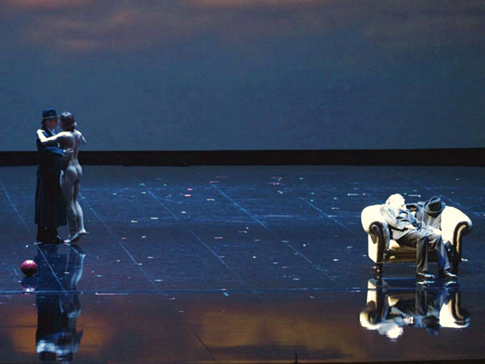 left: Uli Kirsch (Tadzio) [with Aschenbach’s Dopplegänger], right: Hans Schöpflin (Aschenbach)
left: Uli Kirsch (Tadzio) [with Aschenbach’s Dopplegänger], right: Hans Schöpflin (Aschenbach)
The same struggle between life and death breathed from the orchestral pit, mirroring the shifts of wind and tide from the iodine scent of the open sea to the heavy stench of the Lagoon in Summer and back — a common experience for Venice visitors, cleverly described in the libretto. Under Sebastian Weigle’s baton, the taxing score emerged in a glory of harmonies and colors: full-tone scales alternating with polytonalism, piano with Java-style gamelan and far-away echoes of the Baroque. Also the singing company was top-level. The German tenor Hans Schöpflin spun his exquisite mezza voce over the stream of inner monologues and extatic flourishes devised by Britten for his aging mate Peter Pears. Aschenbach’s protean opponent, tempter, flatterer, was the Texan baritone Scott Hendrick, always magnetic throughout his seven so diverse roles. Countertenor Carlos Mena, a reputed Baroque specialist, lent his sunny and mellow alto range to Apollo’s oracles. Within the swarm of cameo roles, particular praise was deserved by the sanguine Begoña Alberdi in the double bill of Strawberry Seller / Newspaper Seller, and by Leigh Melrose, a New Yorker, whose extended narrative solo as The English Clerk in the travel bureau (“In these last years/ The Asiatic cholera has spread/ from the Delta of the Ganges”) conveyed a thrill of Doomsday.
Carlo Vitali
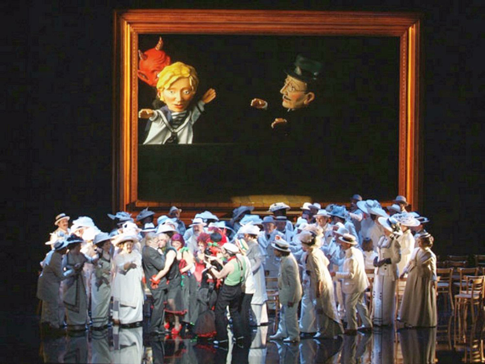 Death in Venice, Act 2, sc. 10 (The strolling players)
Death in Venice, Act 2, sc. 10 (The strolling players)
A new co-production with Teatro Real, Madrid
Performance of 30 May 2008 product_id=Above: Waltraut Meier (Sieglinde), Plácido Domingo (Siegmund)
All photos © Antoni Bofill
June 9, 2008
Songs by Henry & William Lawes
Blaze sings with consummate control, impressive technical agility, a broad dynamic range and expressive flair; Kenny is his perfect accompanimental match, playing with flexibility, engaging adornment, dynamism, and unusual clarity of tone.
Many of the pieces here show the English response to continental progress, advances that travel, international marriages, publication, and the presence of foreign musicians at court would have made familiar. Italy’s new text-centered baroque aesthetic, defined in works like Caccini’s Le nuove musiche, found an English echo in expressive, songs with declamatory elements and Italianate ornamental idioms. Henry Lawes’ “A Tale Out of Anacreon” and “Amarillis by a Spring” or William Lawes’ “O Let Me Still and Silent Lie,” are fine examples of this Anglo-Italianism; the “aye me” of “O Let Me Still and Silent Lie” is as doleful as any madrigalistic ohime. Compositional tongue in cheek, in the song “In quell gelato core,” Henry Lawes went so far as to set the table of contents of an Italian song anthology, a convincing aria di piu parte with all Italian idioms and ornamentations “thereunto appertaining.”
The serious, impassioned Italianate songs are placed in counterpoint here with instrumental pieces—the broody and moody lute fantasia by Cuthbert Hely is especially notable—and strophic songs with triple meter dance elements like “O My Clarissa” or “Amidst the Myrtles as I Walk.” The performances of these songs are unflaggingly captivating, not least for the animating and beguiling use of the plucked strings. With harp, guitar, and theorbo all engaged, who can resist? Although historically it is the declamatory songs that have seemed most significant, in this anthology, I suspect it is these pieces that will most readily gratify, a pleasant reminder of the congeniality of the English ayre and the persistence of its tradition.
The saga of the Lawes brothers is one marked by sad poignance, for William lost his life in 1645, fighting for the royalist cause at the Battle of Chester. The concluding work on the recording is Henry’s “Pastoral Elegie to the memory of my deare Brother.” The text speaks of William’s ability to “allay the murmurs of the wind,” to “appease the sullen seas,” to “calme the fury of the mind.” The imagery here reminds of the Orpheus archetype certainly, but in more concrete terms, it underscores the dynamic power of musical expression. In the “Songs by Henry & William Lawes,” this is amply and wonderfully on display.
Steven Plank
image=http://www.operatoday.com/Lawes_songs.png
image_description=Songs by Henry & William Lawes
product=yes
product_title=Songs by Henry & William Lawes
product_by=Robin Blaze, countertenor; Elizabeth Kenny, lute and theorbo; with Rebecca Outram, soprano; Robert MacDonald, bass; William Carter, lute, guitar, and theorbo; Frances Kelly, double harp.
product_id=Hyperion CDA67589 [CD]
price=$21.99
product_url=http://www.arkivmusic.com/classical/album.jsp?album_id=150297
Star Power in Paris “Capuleti”
No question that soprano Anna Netrebko is one of opera’s most visible, most glamorous, and most sought-after marquee names. And the French are positively nutty for mezzo Joyce DiDonato (the rest of the world is catching up) who has scored several (deserved) major career successes in the French capital. Small wonder then that there was a profusion of musical thrill seekers brandishing “je cherche billets” placards outside the sold-out Bastille house.
To get it out of the way up front (as it were): in spite of being five months pregnant, Ms. Netrebko was a radiant and wholly successful “Giulietta.” She was beautifully costumed in a flowing white gown to minimize the modest protrusion of a tummy, and she moved with her usual freedom and grace, including carefully assisted kneeling and fainting moments as required by the plot. Only when she was flat on her “dead” back did her condition become more apparent.
Her full-bodied, creamy lyric voice not only rang out thrillingly in the hall, but she commanded several breathtaking high-flying pianissimi as well. In her current “condition” it seemed that she may have divided up a few of the longer phrases to maintain breath control, but nowhere was this disturbing to the overall line. She nailed all of the familiar set pieces, and the audience responded with predictably enthusiastic ovations.
For all her star quality, natural beauty, musical gifts, and attendant adulation, Ms. Netrebko seems to be a sincere and unaffected colleague, deferring the stage to her co-stars as the focus of the drama requires. A wonderful collaborator, a fine voice, alluring presence, Anna is the real deal without seeming to be a real diva.
To say that she was matched in star power by mezzo Joyce DiDonato’s “Romeo” would be an understatement. Ms. DiDonato has a wide-ranging, high-powered, personalized and slightly reedy voice that she deploys fearlessly to communicate every fine point of this complicated love-torn character. There is no nuance of this role that escapes her. The deeply felt cry when “Giulietta’s” corpse was unveiled broke my heart. She is a fine artist, with perfect diction and total understanding of the text and the internalized emotion behind it. For the record, she was given the final bow, after the more famous Anna (perhaps because the soprano has asked that Patrizia Ciofi spell her for three performances of the run?).
As if these two would not be enough cause for celebration, the entire show was cast from strength. Mathew Polenzani (“Tebaldo”) served notice right at the top that we were in for a sensational night, his refined lyric tenor ringing out in the house, and his first aria/cabaletta as fine as we could wish. “Lorenzo” was so well-voiced by Mikhail Petrenko, and “Capulet” by Giovanni Battista Parodi that it was a pity there was not more for them to do.
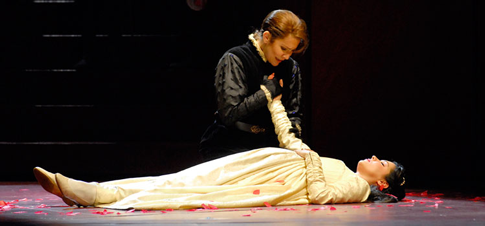 Joyce DiDonato and Anna Netrebko (Photo by Christian Leiber courtesy of Opéra national de Paris
Joyce DiDonato and Anna Netrebko (Photo by Christian Leiber courtesy of Opéra national de Paris
Robert Carsen directed the original production and it is hard to know how much he participated in the revival. An assistant, Isabelle Cardin is also credited. Whoever, this was excellent work. Carsen knows how to place singers on the stage so we are hearing them to maximum advantage, and he knows how to move them logically to those positions through motivated blocking and well-considered character interaction. Good God, a director who knows how to tell the story!
He found an excellent partner in Michael Levine, whose handsome red-paneled walls provided a wonderful playing space with the simple addition of set pieces (stairs, bed, banquet table). The chapel was especially effective with a wide band of light emanating from up left and rows of chairs as pews providing all that was required. The tomb was no less effective, with one wall panel tellingly removed to create a tomb that was ready to accept “Giulietta,” who lay in a pool of light surrounded by flower petals, and was backed by back-lit choristers on a slightly akimbo staircase.
The team immediately established the important background of conflict by having swords stuck in the stage apron which were plucked up by the assembling “Capulets” during the overture. This visual theme was returned to at the end of Act One when the clans square off by advancing on each other and locking weapons in a group freeze center stage at curtain fall. And in a brilliant tweak, at work’s end the two forces assemble in the same aggressive tableau around and over the dead bodies, visually stating that no matter how profound the tragedy, we will walk over the corpses to have history repeat itself.
One other brilliant touch: Act Two opened to the same chapel as had closed One, but revealing dead bodies and over-turned chairs, the sad result of war. As “Giulietta” sank down to her “death,” the dead rose again in a chilling effect, as if on Judgment Day, to welcome her to their ranks. The sumptuous red velvet period costumes (black for the “Montagues”) were exactly right, and provided an elegant sense of time and place.
Conductor Evelino Pidò’s reading of this score was a revelation. I cannot ever remember being so persuaded by the music, or so engaged in, and moved by the drama of Bellini’s somewhat flawed version of the famous tale. The solo work from the clarinet, cello, harp, and horn was top drawer, and indeed the entire orchestra performed splendidly.
There are those who may have come to “I Capuleti e i Montecchi” because it was “the event” of the season, but they most certainly stayed to cheer it to the rafters because it was just so damn’ good. Make that “great.”
James Sohre
image=http://www.operatoday.com/content/bellini_medium.jpg image_description=Vincenzo Bellini product=yes product_title=Vincenzo Bellini: Les Capulets et les Montaigus product_by=Capellio (Giovanni Battista Parodi), Giulietta (Anna Netrebko), Romeo (Joyce DiDonato), Tebaldo (Matthew Polenzani), Lorenzo (Mikhail Petrenko), Orchestre et Choeurs de l’Opéra national de Paris, Direction musicale (Evelino Pidò), Mise en scène (Robert Carsen), Décors et costumes (Michael Levine), Lumières (Davy Cunningham), Chef des Choeurs (Alessandro Di Stefano).Opera with a human heart
Supernumeraries infiltrated the chorus, and sets and costumes went beyond the most extravagant excesses of Hollywood. Eat your heart out, Cecil B. DeMille! Opera — growing in popularity by the season — became the opium of the masses, and directors vied with each other in productions that took the breath away. Forget the plot and the music written for it; the show was the thing!
Texas’ 62-year-old Fort Worth Opera — it’s a senior among American companies — is out to restore a proper balance, and the four productions currently on stage there in the FWO’s second summer festival stress that this is no longer just another regional company, but an enterprise that has defined for itself a special identity through its commitment to fidelity, to composers’ intentions, to perceptive direction and a finely honed sense of what it is that makes opera both grand and great. The Turandot that opened the festival on May 24 made all this clear. For those who wanted awe, it was there in the staging designed by Peter Graves and Allen Charles Klein for Opera Cleveland. However, it was Daniel Pelzig’s sensitive direction that made this refreshingly fascinating Puccini.
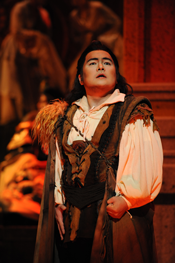 Dongwon Shin as Calaf
Dongwon Shin as Calaf
Turandot is a troubling tale. The eponymous heroine isn’t the
girl next door; she’s downright nasty, a trait of character underscored by
the ease with which she condones the murder of sweet and innocent Liú, the
one genuinely good character in the story. In most productions Turandot is a
simplified study in frigidity — an ice sculpture imperially above the
masses on stage with half of Beijing’s Imperial City on her head and
shoulders. Pelzig made her mobile and an agitated presence in her own story.
The prehistory of abuse to a female ancestor became a document of modern
feminism as she stood next to Liu’ in the younger woman’s hour of
sacrifice. And Carter Scott, who stepped in for an ailing Elizabeth Bennett,
has the power, passion and agility of voice to make Turandot a portrait of
deeply internalized suffering. (The goodness of Liú, sung with youthful
devotion by Sandra Lopez, even lost some of its appeal through this
meaningful feminization of the Princess.)
Given the paucity of tremendous tenors today it is astonishing that one has to go to Fort Worth to discover Korean-born Dongwon Shin, whose throbbing “Nessun dorma” would leave the citizens of any city willing to surrender a night of sleep to hear the greatest hit in the opera sung with his ardor. Stephen Dubberly had the massive FWO Chorus making music — not merely noise, and FWO music director Joseph Illick extracted playing from the Fort Worth Symphony that added to the impact of a Turandot that one had hoped one day to hear.
Anthony Dean Griffey, a major success of the season at the Met as Britten’s Peter Grimes, has made Lennie, the retarded central figure of Carlisle Floyd’s Of Mice and Men a signature role, and it’s wonderful that audiences can expect the young American tenor to sing this role for decades to come.
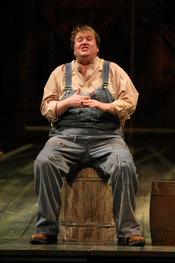 Anthony Dean Griffey as Lennie
Anthony Dean Griffey as Lennie
Even Griffey’s considerable bulk contributes
to his success as Lennie, for he seems at first blush just another overweight
kid. But watch his fingers as he seeks solace in “something soft.” Keep
an eye on his smile and the little skip that he executes from time to time
and you’ll swear that you have a genuine case of arrested mental
development in front of you. Griffey makes Lennie loveable and he makes his
relationship with his companion George — both migrant workers from the
Great Depression — meaningful and beautiful.
George could hardly be better sung than he was by Canadian baritone George Addis, another of astonishing FWO artists to watch for elsewhere. Brandi Icard, true, was one dimensional as Curley’s love-starved wife, while Matt Morgan made Curley the quintessential American macho male, recalling Annie Proulx’ pronouncement that “men are the major victims of American masculinity.”
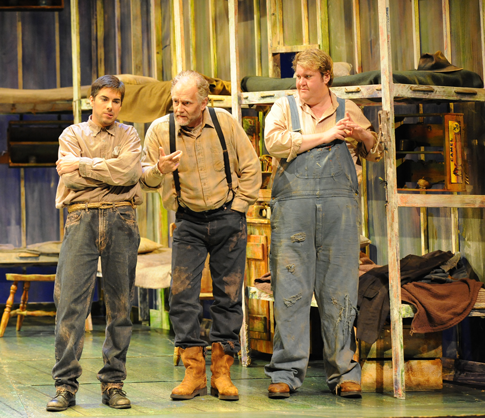 Phillip Addis as George, Stephen West as Candy, and Anthony Dean Griffey as Lennie
Phillip Addis as George, Stephen West as Candy, and Anthony Dean Griffey as Lennie
The Utah Opera production — sets and costumes by, respectively, Vicki Davis and Susan Memmott-Allred — recalled Grant Wood, and Richard Kagey’s direction upheld the view that this 1971 score is Floyd’s finest work. Illick was again an impressive conductor, especially in the orchestral interludes that put Floyd on a level with the Anton Webern of Wozzeck.
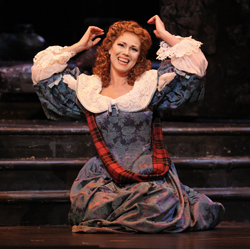 Elizabeth Futral as Lucia
Elizabeth Futral as Lucia
Despite it’s greatest “hits” — the sextet and the Mad Scene —
the bel canto melodrama of Donizetti’s Lucia di Lammemoor is not
everyone’s tankard of ale. A less-than-great performance is uncomfortably
close to parody, and its glaring rejection of traditional family values is
wasted on those interested only in coloratura acrobatics. How different,
however, the FWO Lucia directed by David Gately and conducted by
Steven White!
Lucia has rarely had a better interpreter than Elizabeth Futral, cast by the FWO in the title role. She is one of the loveliest singers of her generation, and she makes bel canto seem her mother tongue. She is wonderfully vulnerable — even when one wishes she would take a knife to Brother Enrico. Futral sang the Mad Scene with delicate sensitivity, never reveling that that’s only catsup and not blood on her hands and gown, Yet this show was almost stolen from her by youthful and up-coming tenor Stephen Costello as losing lover Edgardo, a role he has already sung at the Met. In his cemetery lament in the final scene of the opera Costello, lean and handsome at a mere 28, sang his way into this music with a richness of tone, accuracy and articulation that had the audience on its feet, suggesting that the next great tenor is now — and in Fort Worth.
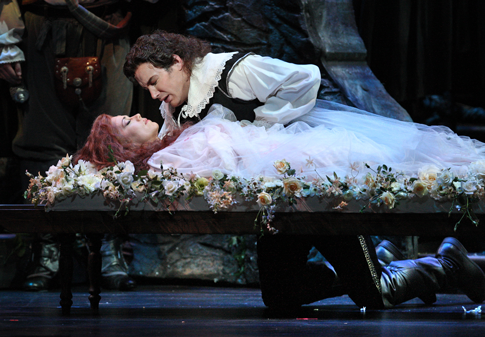 Elizabeth Futral as Lucia and Stephen Costello as Edgardo
Elizabeth Futral as Lucia and Stephen Costello as Edgardo
The Cincinnati Opera production is traditional and true to the period and it gained color through lavish costumes from near-by Dallas. The chorus seemed to have had one — or two — too many in the orgiastic post-wedding revelry.
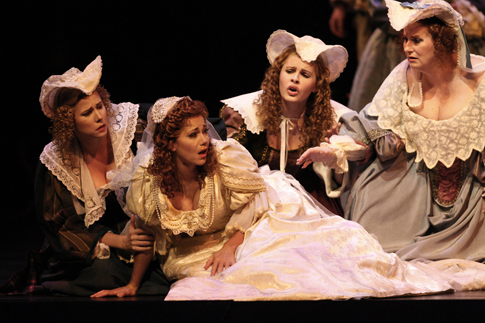 Alissa Anderson, Elizabeth Futral, Allison Whetsel and Pamela Grayson
Alissa Anderson, Elizabeth Futral, Allison Whetsel and Pamela Grayson
Homosexuality might have come a long way since the day that it was — said Oscar Wilde — “the love that dare not speak its name” to — as someone quipped in the 70s — the love that won’t shut up. Nonetheless, the composition of an AIDS opera is a task far removed from dashing off another Bohème or Butterfly.
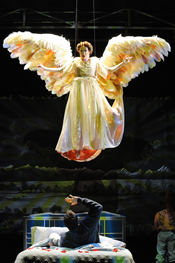 Prior’s (David Adam Moore) prophetic visions culminate in the appearance of an imposing and beautiful Angel (Ava Pine) who crashes through the roof of his apartment and proclaims, “The Great Work begins.”
Prior’s (David Adam Moore) prophetic visions culminate in the appearance of an imposing and beautiful Angel (Ava Pine) who crashes through the roof of his apartment and proclaims, “The Great Work begins.”
That alone, however, makes
Peter Eötvös’ opera based on Tony Kushner’s Angels in America
all the more remarkable — and admirable, and the choice of the work to
round out the FWO’s second festival season is to be praised as an act of
bravery and bravura. This obviously begs the question about the quality of
the opera, which received its first full staging during the festival in Fort
Worth’s 500-seat Scott Theater in the city’s museum district. (The other
three operas were staged in the city’s still new downtown Bass Performance
Hall.) In shaving Angels down from a seven-hour stage work to an
opera of a mere two hours Mari Mezei has made a noble attempt to transfer the
drama — and its discomforting subject matter — to another medium.
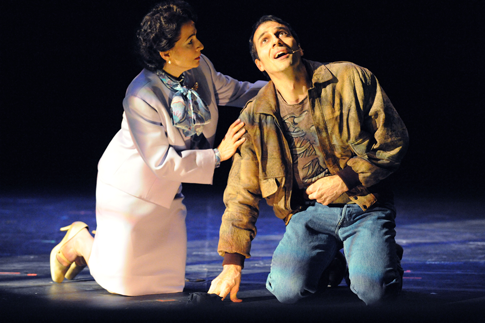 Hannah (Janice Hall) helps Prior (David Adam Moore) who is sick with AIDS
Hannah (Janice Hall) helps Prior (David Adam Moore) who is sick with AIDS
Hungarian-born Eötvös, a major European modernist in the wake of the Second Viennese School, has written much music for the opera that is of ethereal beauty and impressive in technique. (Much of it is delivered by musicians screened on either side of the stage.) Yet the result seems a work in which less is much less; too much has been lost in transition. An immense amount of detail obscures the major issues of Kushner’s play.
With the efforts of a brilliant creative team — conductor Christopher Larkin, director David Gately, designers Peter Nigrini and Claudia Stephens — made Angels a work decidedly worth seeing. And the cast, headed by veteran soprano Janice Hall and Erin Elizabeth Smith, delivered lines ranging from speaking to Sprechstimme to singing with amazing aplomb.
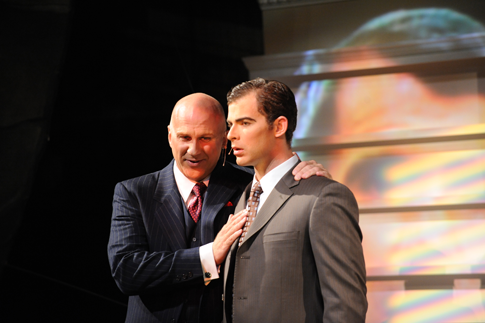 Left to Right: Roy Cohn (Kelly Anderson) and Joe Pitt (Craig Verm) talk politics
Left to Right: Roy Cohn (Kelly Anderson) and Joe Pitt (Craig Verm) talk politics
Kelly Anderson was a brilliantly butch Roy Cohn (but who remembers today who that was?), and studio artist Ave Pine was vocally stunning as the major angel who flew about on wires while singing famously. In all probability Angels will not be done again in this country in a long, long time, and one is grateful to FWO general director Darren K. Woods for his courage in bringing it to the festival.
A bonus of the ’08 season was the inclusion in the season of Ricky Ian Gordon’s Orpheus and Euridice, his song cycle for soprano, clarinet and piano. The performance by Gina Browning, virtuoso clarinetist Jonathan Jones and Illick at the piano was part of More Life: The Art & Science of AIDS, a series of concurrent events involving a multitude of Fort Worth community organizations designed to focus attention on the AIDS epidemic.
On stage in Fort Worth in 2009 are Carmen, Cinderella and Dead Man Walking. The season from 25 April through June 10 is followed immediately by the 2009 Van Cliburn International Piano Festival. Visit www.fwopera.org.
image=http://www.operatoday.com/1212073107_carter_scott_as_.png image_description=Carter Scott as Turandot (Photo by Ellen Appel courtesy of Fort Worth Opera) product=yes product_title=FWOpera Festival product_by=Above: Carter Scott as Turandot product_id=All photos Ellen Appel/Fort Worth OperaSt. Francis in Amsterdam
Nearly everything about the writing seems over the top. Its incredible length. Its massive orchestral forces. Its sanctimonious religious posturings. All seems calculated not just to merely impress or to move, but to wallop you over the head with some quasi-spiritual revelation.
In assessing the stage worthiness of lyric theatre pieces, Joseph Kernan wrote “the best operas are dramatic, the failures are no proof at all.” Let’s just say that “Saint François” is to my taste, well, not dramatic. Most everything about it resembled a cleverly staged oratorio. To that end, the gigantic orchestra was placed on stage (it probably wouldn’t fit in the pit!). Scaffolding and ramps and a huge balcony are built around the band, intentionally including it in the stage picture.
That leaves the simple story to play out on the huge apron in front of it which covered the unused pit. And the dramatic content of that story goes something like this: Saint counsels fearful monks. Saint heals leper. Saint talks to birds. Saint receives stigmata. And dies.
Oh, yeah, and a busybody angel visits and spooks the bejesus out of the scaredy-cat monks. I joke — slightly — but this thin plot is stretched out of all proportion into well over five hours. What almost energizes and sustains the story-telling is the masterful stagecraft of designer Jean Kalman and director Pierre Audi, for they have devised some beautifully evocative effects.
Act One finds a pile of simple (mostly black) wooden crosses center stage, a lone bench, and a “reveal” of a pulpit on an elevated platform. As other crosses are added to the pile, the imagery suggested so many possibilities. Do they represent of martyrs’ bodies? A pyre created by religious fanaticism? Holocaust victims? It raised expectations (unfulfilled, alas) that the piece might have something to say beyond presenting a public face of the composer’s private, deeply felt Catholicism.
Although that imagery was never fully developed, Act Two’s stylized rolling trees made of bare planks always reminded us that the cross of Christ was in fact made from a tree, and the slightly raked black platform center stage allowed for some beautiful artistic groupings which were put into fine dramatic relief against the ground cloth. In Act Three, the crosses were piled up in a semi-circle at the base of a lone rude tree, like so much concertina wire forming a base of thorns. The simple small wooden platform in front of this was a perfect focus for “François’” last moments.
Audi is a master at slowly building visual tension; and delving deep into characters’ souls to devise complex relationships, varied stage movement, and evolving pictures of complete inevitability. He did his level best to wring every last viable possibility out of the repetitive moments of the repetitive moments of the repetitive moments of the . . .stop me!
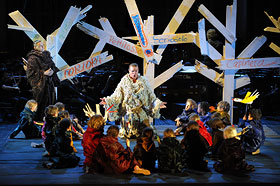 The well-crafted straight forward confrontation between “Saint
François” and the “Leper” fairly crackled. A wonderfully tender
relationship was developed between “François” and the fearful
“Léon,” which seethed with subtext. “The Angel’s” every scene had
a haunting visual beauty and meaningful interaction, with excellent use of
levels for psychological impact.
The well-crafted straight forward confrontation between “Saint
François” and the “Leper” fairly crackled. A wonderfully tender
relationship was developed between “François” and the fearful
“Léon,” which seethed with subtext. “The Angel’s” every scene had
a haunting visual beauty and meaningful interaction, with excellent use of
levels for psychological impact.
That said, even Mr. Audi and his design team could not salvage the interminable final scene of Act Two with the children and the birds. Long after we got the point, and got it again, like the Energizer Bunny it went on and on and on. Oh, they made a good stab at maintaining our interest with some playful writing of the birds’ names on the bare trees with Magic Marker, and the genial waving about of colorful paper birds. But long after the Marker was dry and arms were dead tired of bird-play, it kept churning, not in a mesmerizing Phillip Glass sort of way, just. ..churning in fits and starts.
Critically, it seemed that “François’” death went for too little. Perhaps we waited too long for it? Or perhaps a better visual solution could have been found other than having the dead man file off between the choristers. Although the lighting was excellent throughout, the script says the final lighting effect should glow blindingly brighter where “François” had lain. Instead, a truncated bank of orange lights glared from behind the upstage scrim like back lighting left over from the Vegas scene of “Dreamgirls.”
Happily, Netherlands Opera’s reliably high quality visuals were matched by a truly wonderful cast. Camilla Tilling’s engaging “Angel” walked off with the show and it is easy to see why. She is possessed of a clear, lovely soprano with plenty of point in all registers. She sings the role with great understanding, masterful phrasing, and complete control of the musical challenges. And, she quite simply has the most beautiful and accessible music in the piece, which she serves very well.
Hubert Delamboye has only once scene as “The Leper” but he wrung every ounce out of it with fiery, securely voiced declamation. The effect of his being cured was magically created by his simply peeling off one of his garish gold and black sleeves to reveal his pure flesh unadorned. Both baritone Henk Neven (“Frére Léon”) and tenor Tom Randle (“Frére Massée”) turned in performances that could not be bettered. In a piece of luxury casting, heroic leading tenor Donald Kaasch sang a fine “Frére Elie.” Armand Arapian, Jan Willem Baljet, and Andre Morsch contributed solid singing in their smaller parts. The excellent chorus was tremendous in their powerful, meticulously schooled phrasing.
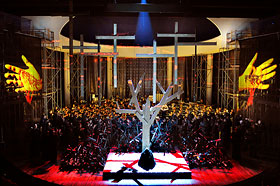 That leaves our “Saint François.” Although he was not announced as
indisposed, popular baritone Rod Gilfry seemed at times like he might have
been a little tired in this first performance after the premiere. He is a
fine singer (as well as actor) and he certainly commands a secure technique.
But this role is a huge step forward from his core repertoire of
“Dulcamara” and “Marcello” and “Papageno.” The rangey writing for
a dramatic baritone (or high bass) who seldom leaves the stage, calls on
every trick in the singer’s bag. I commend Mr. Gilfry for the considerable
success he has had with this assumption, and the fact that he has learned
this demanding part speaks well for him as a serious artist.
That leaves our “Saint François.” Although he was not announced as
indisposed, popular baritone Rod Gilfry seemed at times like he might have
been a little tired in this first performance after the premiere. He is a
fine singer (as well as actor) and he certainly commands a secure technique.
But this role is a huge step forward from his core repertoire of
“Dulcamara” and “Marcello” and “Papageno.” The rangey writing for
a dramatic baritone (or high bass) who seldom leaves the stage, calls on
every trick in the singer’s bag. I commend Mr. Gilfry for the considerable
success he has had with this assumption, and the fact that he has learned
this demanding part speaks well for him as a serious artist.
Indeed, he always displayed utter commitment and total concentration, and lavished us with beautiful outpouring of sound. But it did push him to the limit. For all his success with it, I wonder if he might not retire the role from his repertoire for a few years until age provides a bit more heft and stamina? With his chiseled good looks and designer white robe, he did not look the ascetic monk so much as a very caring fashion model (is there such a thing?) before a Prada ad shoot. Other than that, I found Angelo Figus’ costumes highly creative and character-specific. The “Angel’s” several apparitions were beautifully attired, especially her knock-out plastic gown that looked like a Kandinsky had collided with a shower curtain. No kidding. Wild and wonderful!
It is hard to over-praise Ingo Metzmacher and his superb Resident Orchestra for their thrilling reading of this gigantic score. Their attention, concentration and musicality never flagged over an exceedingly long evening. For all my reservations about the dramatic viability of the piece, there is some remarkable writing in it. All of the “Angel’s” scenes, including her motif are ravishing; the “Leper” is well characterized; the choral writing is compelling; and “François’” solo and duet scenes with “Léon” and “Massée” contain many serenely beautiful musical themes and haunting melodies.
But that jittery wind section repeats about ten times too often, and what seem to be logical musical climaxes simply frustrate us by morphing into another repetitive section, or more jittery winds. To me, it seemed that Messiaen the Catholic sometimes indulgently eclipsed Messiaen the musical crafts smith.
Is “Saint François d’Assise” a viable opera? Kernan be damned, Netherlands Opera thinks it is. And they are to be congratulated for coming to grips with it with well-considered solutions, and for treating us to a thoroughly engaging and uncompromisingly professional production.
James Sohre
image=http://www.operatoday.com/St_Francis_01.png image_description=Olivier Messiaen: Saint François d’Assise (De Nederlandse Opera) product=yes product_title=Olivier Messiaen: Saint François d’Assise product_by=L´Ange (Camilla Tilling), Saint François (Rod Gilfry), Le Lépreux (Hubert Delamboye), Frère Léon (Henk Neven), Frère Massée (Tom Randle), Frère Élie (Donald Kaasch), Frère Bernard (Armand Arapian), Frère Sylvestre (Jan Willem Baljet), Frère Rufin (André Morsch), Residentie Orkest, Koor van De Nederlandse Opera, directed by Martin Wright. product_id=All photos courtesy of De Nederlandse OperaJune 8, 2008
Central City Opera at new height
 Wes Blomster [Daily Camera, 8 June 2008]
Wes Blomster [Daily Camera, 8 June 2008]
CENTRAL CITY-- "Benjamin Britten's "Rape of Lucretia" might seem hopelessly complex, but it's really only "Cosi fan tutte" seen through a glass darkly.
Opera: An inquisition devoid of opinion
 By Andrew Clark [Financial Times, 8 June 2008]
By Andrew Clark [Financial Times, 8 June 2008]
There are two ways of reading the Royal Opera’s new Don Carlo. The first goes something like this: tenor-of-the-moment Rolando Villazón returns to the stage after months of indisposition and crowns a front-rank cast in a subtly delineated version of Verdi’s Spanish drama, masterminded by “the most influential arts figure in the UK” – Nicholas Hytner of London’s National Theatre.
Zurich Has Malibran to Thank
Ms. Bartoli is the raison d’etre for Zürich Opera’s colorfully mounted rarity, continuing in her celebration of the 200th anniversary of operatic legend Maria Malibran for whom the piece was written. But for our star’s committed interest, I am not sure it may have seen the light of day, nor certainly would it have scored such a big success with its public.
In case you have missed it, Ms. Bartoli has made a specialty of late unearthing little-known pieces and/or creating compilation albums around themes, or composers, or both. Witness the recent promo campaign attending the release of “Maria,” a CD in which she (quite spectacularly) covers all things Malibran. Happily, Ms. Bartoli’s unquenchable musical curiosity (and perhaps, marketing acumen) are wedded to a passionate artistry, unfailing musical and dramatic instincts, and a uniquely personal sound served by a reliably sure-fire technique.
Indeed, in “Clari” it seemed there was nothing our diva could not do. Complex arpeggiated licks, perfect trills, spot-on wide-ranging interval leaps, superb diction, secure tone in all gradations of volume, melting lyrical outpourings, and nuanced coloratura with fiery temperament — all were on display in La Bartoli’s bravura performance. An added plus is that the smallish Zürich house perfectly showcases her medium-sized voice. Oh, yeah, and she is simply a beautiful woman with an effortless star presence.
The company assembled a strong cast to partner one of the world’s most famous singers. As the “Duke,” tenor John Osborn displayed a very winning presence and lovely voice with a solid technique that allowed him to not only match Ms. Bartoli in their sizzling duets, but also to pin our ears back with some dandy climactic high notes. Mr. Osborn surely must be numbered among today’s top leggiero tenors.
Eva Liebau deployed her clean,sparkling soprano to good end as “Bettina” especially with a well-sung canzonetta. As the father “Alberto,” Carlos Chausson made every booming note count and offered a well-rounded, humorously self-pitying portrayal. Slightly less effective, although still eminently enjoyable, were Stefania Kaluza’s mother “Simonetta” and Oliver Widmer’s “Germano.” The former sometimes seemed short of voice at the break, and the latter sometimes disappeared into the orchestral textures in florid passages.
The well-tutored chorus sounded good, wore their succession of outlandish costumes well, and did every goofy piece of stage business and choreography (by Beate Vollack) that was asked of them with dedication and good humor. And now we arrive at the goods news/bad news part. But first, bear with me.
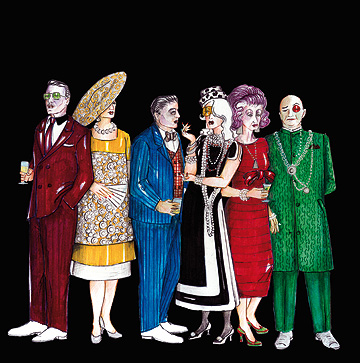 Some years ago, before I really knew Handel’s “Giulio Cesare” at all
well (or really, at all), I saw a dizzy Euro-putzy production of it based on
the comic book “Asterix and Cleopatra.” Well, you can imagine what it was
like, right? But not knowing any better, it was well sung, so I really sort
of liked it. Never mind that it was entirely the wrong tone for the piece. I
had fun, dammit, laughing in all the wrong places. And that is a bit how I
felt as I was discovering this production of “Clari.”
Some years ago, before I really knew Handel’s “Giulio Cesare” at all
well (or really, at all), I saw a dizzy Euro-putzy production of it based on
the comic book “Asterix and Cleopatra.” Well, you can imagine what it was
like, right? But not knowing any better, it was well sung, so I really sort
of liked it. Never mind that it was entirely the wrong tone for the piece. I
had fun, dammit, laughing in all the wrong places. And that is a bit how I
felt as I was discovering this production of “Clari.”
For it seems that its gentle charms should be more akin to the sincere and sentimental village milieu of “Sonnambula” than Act I’s nutty Once-and-Future-Guggenheim of a drawing room. Brazenly colorful modern furniture provides a modest island of repose in a riot of modern art, not least of which is a huge bright red bust of a gorilla. Which our heroine mounts in an unhinged Fay Wray moment at Act One’s end. Not to impugn Christian Fenouillat’s witty and beautifully executed designs. Setting Act II in a very realistic modern hospital waiting room, into which the female chorus of nurses wheels the suffering “Clari” in a hospital bed, was brilliant. As was Act III’s shallow farmhouse kitchen and entry way (with soiled rubber farm boots lined up). The goof of having a drop with a valentine cut-out fly in to frame our heroine for her final solo as she pokes her head through the hole left for the bride’s head was a delight.
Too, Agostino Cavalca’s colorful costumes were perfectly calibrated to support the concept, notably the bumble-bee-black-and-yellow servants costumes, the outrageous “beautiful people” look at the birthday party, and the pseudo-Alpine dress for the peasants. It must be said that Ms. Bartoli was ravishingly attired. Her first entrance costume was an ice blue sequined suit, rivaled by her birthday party get-up as she pops out of a cake in a bugle-beaded pink strapless cocktail dress. Stunning. Even her peasant dress flattered and did not visually let us forget who was the star.
More Good News: Moshe Leiser and Patrice Caurier co-directed their principals exceedingly well. There was nice, varied blocking with good motivation and character interplay. They invented meaningful and clever business for the very long set pieces to inject variety and (yes) humor. The “Duke” as preening peacock (Liberace with a nod to Elvis) was a winning touch, and his vamping of “Clari” by slipping his robe off his shoulder (yeah, like that would inflame her) was a hoot.
Another brilliant device was the use of a framed “painting” in the opening location, which morphed into a succession of projected photos detailing the prequel to the opera’s action, namely “Clari’s” leaving home and being held captive by the “Duke.” Funny funny images that did, however distract from the long, well-played intro to the soprano’s opening aria. The bit of “Clari” hiding herself from her dad in the farm vestibule by putting a coat over her head to match the other similarly adorned coat hooks was another master stroke. And I loved “Duke’s” third act entrance in a roadster.
Bad News Part: I wish the directors had showed more care with their uses of the chorus. Often they were relegated to performing the most cliched and timeworn shtick, looking all the more obvious for having it amid so many other inventive goings-on. I mean, please, servants endlessly “polishing” the same spot on the chair/floor/wall/air/fill-in-the-blank? And doing ersatz Teutonic folk steps that would have been rejected from “The Producers”? We have seen it all before and these guys are too good to settle for that.
Things in the pit were under Adam Fischer’s sure hand. He elicited secure playing from the resident “La Scintilla” period instrument band. I am not sure that this sound made the best possible case for Halevy’s score, but, save for a few periodic stroppy moments in the horn section, they played with stylistic commitment. Side note: I have never ever in my life seen/heard an orchestra tune this much. They easily took five minutes to do just that after we were all ushered to our seats in a very hot auditorium. Maybe they could start tuning up before the house manager rings the bell?
“Clari” is not likely to show up in many (if any) other major houses, but it might be a good fit for smaller opera festivals looking for intriguing variety. Glimmerglass? St. Louis? The score is certainly pleasing enough, and true to its times and performance practices, Ms. Bartoli interpolated a Rossini aria as well as an Halevy aria from a different piece into the performance. (Hell, we would have listened to Cecilia do “Proud Mary” if she wanted!)
Quibbles aside, with “Clari,” Zürich Opera produced a solid success, well cast, with excellent production values, and an all-too-infrequent chance to revel in Cecilia Bartoli at the top of her game. Really, does opera get much better than that?
James Sohre
image=http://www.operatoday.com/bartoli_cecilia07.png image_description=Cecilia Bartoli product=yes product_title=Jacques Fromental Halévy: Clari product_by=Above: Cecilia BartoliMusic al fresco
 By Richard Fairman [Financial Times, 5 June 2008]
By Richard Fairman [Financial Times, 5 June 2008]
Having ambitions never did an opera company any harm. It might seem an act of hubris for a company of limited resources to take on La fanciulla del West, the opera where Puccini puts a widescreen melodrama from the wild west on the stage, but Grange Park Opera have given it their best shot.
MOZART: La Clemenza di Tito — ENO 2007
Music composed by W. A. Mozart. Libretto by Pietro Metastasio, adapted by Caterino Mazzolà.
First Performance: 6 September 1791, National Theatre, Prague.
| Principal characters: | |
| Tito [Titus Flavius Vespasianus], Roman Emperor | Tenor |
| Vitellia, daughter of the deposed Emperor Vitellius | Soprano |
| Servilia, sister of Sextus, in love with Annius | Soprano |
| Sesto [Sextus], friend of Titus, in love with Vitellia | Soprano |
| Annio [Annius], friend of Sextus, in love with Servilia | Soprano |
| Publio [Publius], prefect of the praetorian guard | Bass |
Setting: Rome, c. 80 C.E.
Synopsis:
Act I
Scene 1. Vitellia's apartments
Vitellia, daughter of a previous emperor of Rome, who had hoped in vain to marry the Emperor Tito (Titus), incites Sesto (Sextus) to prove his love for her by killing Tito, despite the fact that he is a friend.
Annio (Annius), a friend of Sesto, brings him a summons from the emperor. Vitellia makes an insulting remark about Tito's love for the Jewish Queen Berenice, only to learn that Tito has parted from her and sent her back home. With renewed hopes of becoming empress, she tells Sesto to defer his assassination plans, giving him no reason, demanding that he trust her. Sesto consents with delight when Annio asks for the hand of his sister Servilia.
Scene 2. The Roman Forum
The people acclaim Tito. He calls Sesto and Annio to him and asks Sesto for the hand of Servilia. Both are taken aback, but Annio collects himself sufficiently to congratulate the emperor on his choice, and is given the task of conveying the news to Servilia.
Tito keeps Sesto at his side, remarking that the joy of rewarding friends is the only pleasure he derives from his position. Annio laments the loss of Servilia and when he tells her of her fate, she also grieves for their lost happiness.
Scene 3. The imperial palace on the Palatine Hill
Publio, commander of the Praetorian guard, brings Tito a list of those who have defamed him and his predecessors. Tito deplores the investigation which has produced the list and forgives those named on it.
Servilia confesses to the emperor that she loves Annio, but agrees to marry him if he still wishes. He releases her from any obligation to him, while wishing that all around him were as frank as she. Vitellia greets Servilia ironically as future empress and beloved of Tito, but Servilia answers cryptically that Vitellia may still be able to marry him. Not understanding, Vitellia rages at having first Berenice, then Servilia prefered to her, and threatens vengeance. She stirs up Sesto again and he promises to avenge her, but when Publio brings the news that Tito has now chosen her as his wife, she regrets the haste with which she sent Sesto off.
Scene 4. The square before the Capitol
Sesto, torn between love and friendship, resolves to die rather than betray his friend, but his plot is already under way and the Capitol is burning. Feeling that he is now committed, he enters the Capitol in search of Tito. A crowd gathers and Sesto appears, announcing the assassination of the emperor. Vitellia warns him not to betray himself.
Act II
Scene 1. The square before the Capitol
Sesto has learnt that he stabbed another man in mistake for Tito. He confesses his attempted crime to Annio, declaring that he will leave Rome as a repentant exile. But he is not yet suspected, and Annio advises that he should continue to serve the emperor and by his fidelity atone for his crime.
But Vitellia counsels him to leave at once, fearing not only for his life, but for her honor as the instigator of the attempt. Sesto swears that her secret is safe with him.
He is arrested by Publio, as the man he had stabbed had not died and had been able to reveal the identity of his attacker. Sesto is led off to be tried by the Senate, leaving Vitellia a prey to remorse.
Scene 2. A great hall
The people rejoice in the safety of Tito and he expresses his gratitude for their devotion. He asks Publio about the progress of the proceedings against Sesto, trying to find excuses for his friend, but Publio can give him no comfort.
Annio begs for mercy for Sesto, but is interrupted by Publio, bringing news of the condemnation of Sesto, who is to be thrown to the beasts in the arena. He hands Tito the death warrant to sign, but the emperor, torn between justice and mercy, decides to hear Sesto before signing. He offers Sesto the chance to exculpate himself, but his lips are sealed by his promise to Vitellia and he says that he deserves and desires death.
Servilia and Annio beg Vitellia, as their future empress, to intercede for Sesto, reproving her when she seems to hesitate. Vitellia is moved to admiration by the steadfastness of Sesto, examines her conscience and resolves to confess, even though it will cost her the throne she has sought and may even mean her death.
Scene 3. The Amphitheatre
The people have gathered for the games in which Sesto is to die. Vitellia confesses, explaining that she had misconstrued Tito's customary affability into expressions of affection and felt spurned when he seemed to choose others instead of her. In the face of so much treachery, Tito decides to be magnanimous, to forgive and forget.
[Synopsis Source: Opera~Opera]
Click here for the complete libretto.
Click here for an analysis of La Clemenza di Tito as propaganda.
image=http://www.operatoday.com/Leopold_II.png image_description=Emperor Leopold II audio=yes first_audio_name=W. A. Mozart: La Clemenza di Tito first_audio_link=http://www.operatoday.com/Clemenza3.m3u product=yes product_title=W. A. Mozart: La Clemenza di Tito product_by=Paul Nilon (Tito)Alice Coote (Sesto)
Emma Bell (Vitellia)
Sarah-Jane Davies (Servilia)
Anne Marie Gibbons (Annio)
Andrew Foster-Williams (Publio)
Orchestra and Chorus of English National Opera
Edward Gardner (cond.)
Live performance: 21 June 2007, Coliseum, London
June 5, 2008
Deborah Voigt - The Return of the Little Black Dress
 YouTube's take on Deborah Voigt's return to Covent Garden in Ariadne auf Naxos.
YouTube's take on Deborah Voigt's return to Covent Garden in Ariadne auf Naxos.
June 4, 2008
Joye: Les plaintes de Gilles de Bins dit Binchois
Björn Schmelzer proposes however that in the musical settings of laments “sorrow is transformed into sublime bliss—the secret of any lament of a high standard,” as Binchois’s surely were. In the creating of this conceptual frame for Binchois’s laments, Schmelzer and his generally excellent Graindelavoix, seek perhaps a new niche in which to place the composer’s works. Unsurprisingly, their performances also seek difference and distinction, be it with exaggerated tempo, degree of ornamentation and improvisation, or an especially “orchestrational” approach, switching and intertwining instrumental and vocal sounds with careful design.
The search for distinctive modes of performance invites us to hear things with new ears. The opening “Adieu mes tres belles amours,” for instance is sung unusually slowly. And the exaggerated pace, somewhat jolting at first hearing, gives the affection of the text (regrettably untranslated in the liner notes) greater gravity. One pauses anew to savor the detail of the musical syntax and one lingers with the sensuous elegance of Patrizia Hardt’s singing. There are trade-offs, however. The very slow speed seems to work against the level of note that was idiomatically the basic unit of motion, and thus may sound more like “slow motion” than expressive enhancement. Significantly, the slow speed well accommodates the florid ornamentation impressively added here by Hardt.. Yet, based on figuration in the Buxheimer Organ Book, the ornamentation sounds anachronistic in the vocal appropriation, and its degree of floridity seems to work against the affective dolor that inspired the choice of a slow speed in the first place.
In the extensive liner notes, Schmelzer writes of archetypal features of laments, including an “atmosphere which enables a kind of feminisation of feelings (high, ornamental or trembling voices, tears, etc.), absolutely impossible in a conventional social context.” The appeal to the “trembling voice” is amply apparent in the singing of Silvie Moors here. A skillful singer with a wide range of activity in jazz and folk styles, she has a tremulosity in her voice that is expressive, but also distracting for its associations with other styles. It is beautiful singing—the kind of sound we often encounter today in modern Celtic folk recordings—but a novel sound in this context. This again invites us to hear things anew—a good thing—but it may also court a degree of mannerism in the end.
Schmelzer gives much attention to vibrant and robust instrumental participation in the performance of many of the laments, again favoring an ornamental and improvisatory style. Occasionally this seems to have hijacked other priorities. For example, the rondeau “Esclave puist yl devenir” has only the refrain sung, while fiddles—a nice salute to the blind Castilian fiddle players at the Burgundian court—render the rest of the musical material. Orchestrationally interesting, it nevertheless runs rough-shod over the song as a textual event, rendering a significant portion of the text silent.
There is much beautiful singing in this anthology. The lament “Mon seul et souverain désir” is simply stunning, set to an unsually low pitch that wraps the tone in a veil of dark profundity. This presages sounds we associate with Ockeghem, who likely studied with Binchois, and whose lament on the death of Binchois is the concluding chanson of the recording.
“Joye” will assuredly be of interest to devotees of early Renaissance music. Some of the performances perhaps try too hard to achieve difference, but in this we also sense a gratifying dynamism in the performance tradition: that, too, is something about which we can be joyful.
Steven Plank
image=http://www.operatoday.com/Binchois.png
image_description=Joye: Les plaintes de Gilles de Bins dit Binchois
product=yes
product_title=Joye: Les plaintes de Gilles de Bins dit Binchois
product_by=Graindelavoix; Björn Schmelzer, Director
product_id=Glossa Music GCD P32102 LC 00690 [CD]
price=$19.99
product_url=http://www.arkivmusic.com/classical/album.jsp?album_id=151386
SCHOENBERG: Moses und Aron
Yet the recently issued DVD of a 2006 production from Vienna demonstrates the power of this work onstage. With the excellent visual dimension, this recording differs from CDs in bringing forth the drama that the composer intended.
The almost legendary two-act torso of Moses und Aron is significant not only for the music it contains in the existing fragment and also for what its composer could have composed for the third act. Such antimonies make the work attractive and also leave the door open for various conceptions of the work on stage. In this relatively recent production of the Vienna Staatsoper that was given in 2006 and subsequently broadcast on Austrian television as a presentation of the ORF, stage director Reto Nickler combines modern dress with elements traditionally associated with the story of Moses. In doing so, Nickler was able to amplify the meaning of certain symbols, such as Moses’s staff by using a video project of it on stage and thus, accentuating its significance. In using a modern, sometimes abstract setting, Nickler also avoided the sand-and-sandal production and, instead, arrived at a setting that allows the audience to focus on the actors on stage and their music. Without sets that sometimes dwarf the performers, the drama emerges readily from the interactions between human characters in this opera of ideas about the nature of God as expressed by the central figure of Judaism, Moses.
While a number of fine recordings of Moses und Aron exist, this unique DVD of the opera makes a staging of the work accessible, with a variety of camera angle, including a judicious mixture of close-ups and longer shots of the stage. The recording is all the more remarkable for its origins in a live performance, since audience sounds are almost negligible in the DVD. It is an exemplary presentation that merits attention for conveying the opera well. With the stage details intact, and the wide-angle shots planned to make the best use of the stagecraft, the Nickler production, prepeared for television by Claus Viller, is a fine example of filmed opera. The sound is quite fine and brings across the nuanced direction of Daniele Gatti, whose efforts join the ranks of other fine interpreters of this work, including Pierre Boulez and Georg Solti.
The principals involved with this production, namely Franz Grundheber as Moses and Thomas Moser as Aron offer excellent interpretations of their respective roles. The sense of line overrides the tightly organized dodecaphonic structure as both singers convey not only the musical character of their lines but also the meaning of the text as a dramatic work. Grundheber is particularly effective in giving the role a physical presence: he is singing as Moses, not performing at the role in a studied fashion. Likewise, Moser’s portrayal of Aron not only serves as foil for Moses, but supports his brother on stage, as he becomes as his character states, the word and deed of the ideas that Moses espouses. If Aron is, at times, at odds with Moses, the resulting duality from these two strong musicians is worth watching on stage, especially in the famous scene where Aron has snatched Moses’s rod and becomes the erstwhile leader of the Hebrews, who are still trying to grasp the spiritually present god who communicates with Moses. With the two principal characters performed so convincingly, it is no wonder that the production was presented on television and preserved on DVD.
Equally convincing are the secondary roles, which emerge facilely from the chorus. At times impassioned, the choral sound is as solid as the finely balanced orchestra, and brings out the carefully constructing writing Schoenberg brought to this work with the chorus becoming, at times, an additional role in the opera. These qualities are present in the scene with the Golden Calf, which becomes here an excellent portrayal of the Hebrews as a people whose response to doubt and fear is exactly what Moses was trying to address by bringing his God to his people. Nickler did not present the scene with the kind of decadence some directors use for the temple scene in Saint-Saëns’ Samson et Dalila, but rather used costumes to denote this aspect of the scene. Likewise, the three-dimensional idol-like presentation of self-interest as found in the work “Ich” (“I”) is at once an apt reference to Freud and a fitting focus of the scene. With Aron as a kind of emcee, this rendering of the scene adds a modern commentary to the idolatry implicit in the text and, of course, explicit in the well-known story. At the same time, the masterful performance of the instrumental interlude contributes to the overall effect of profanation, an idea which remains at odds with the narrative about Moses’s efforts to bring his people closer to the transcendent deity. The impact is stronger later in the scene, when the Israelite men enter with human-size letters that spell out “Ich bin Gott” (“I am God”). The scene dissolves into violence that conflicts with the ideals expressed earlier in the work, and the chorus is commendable in conveying that mood effectively.
When he returns, Moses is not the angry Charlton Heston in The Ten Commandments who hurls the tablets to the ground. Neither is he carrying the tablets, but is yoked by them, with the placards balanced around his neck. His exchange with Aron is intense for its intimacy, and in this production, the two characters emerge as complementary figures, who diverge not by opposing ideas, but different means of expressing their faithfulness to their people. Only when this emerges in the text does Moses attempt to break the tablets and the stylized gestures that accompaniment that seen fit the gestural music that accompanies the scene. The dissonance that is part of this culminating moment in the opera is not strictly tonal, but in this performance emerges as conflicting textures.
Since this is a torso, the performance itself ends where Schoenberg left the work, at the end of Act 2. This DVD includes a reading of the third act, which the composer had completed in libretto. Rendered by Grundheber, this portion of the work is not always available in audio recordings, even though it is an essential part of the legacy of Schoenberg’s Moses und Aron as the basis for the concluding act. Beyond this addition, the DVD itself includes an exemplary booklet that augments the visual presentation, which includes subtitles in French, Spanish, Italian, and English. This production of Moses und Aron is outstanding, and it is fortunate to have it preserved in DVD so that those who may be familiar with the music alone through CDs or radio broadcasts can see an effective performance of the work on stage.
James L. Zychowicz
image=http://www.operatoday.com/101259.png
image_description=Arnold Schoenberg: Moses und Aron
product=yes
product_title=Arnold Schoenberg: Moses und Aron
product_by=Franz Grundheber (Moses); Thomas Moser (Aron); Ildikó Raimondo (Ein junges Mädchen); Janina Baechle (Eine Kranke); Peter Jelosits (Ein junger Mann, Jüngling); Morten Frank Larsen (Ein anderer Mann); Georg Tichy (Ephraimit); Alexandru Moisiuc (Ein Priester). Chorus and Orchestra of the Vienna State Opera. Slovak Philharmonic Chorus. Daniele Gatti, conductor.
product_id=Arthaus 101259 [DVD]
price=$29.98
product_url=http://www.arkivmusic.com/classical/Drilldown?name_id1=10855&name_role1=1&comp_id=27961&genre=33&bcorder=195&name_id=15133&name_role=2
Der Rosenkavalier at ENO
This might perhaps have been a fitting subtitle for ENO’s current production, given John Tomlinson’s tour de force of a performance. He appeared in ENO’s last two stagings (at least once alongside the current Marschallin, Janice Watson) but his Ochs never owned the stage quite like this. The glint in this gravelly bass’s eye is at once repulsive and endearing, and he makes something of every word of Alfred Kalisch’s slightly clunky English translation, a feat equalled only by the excellent Andrew Shore as Faninal.
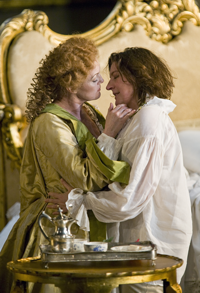 Janice Watson (The Marschallin) / Sarah Connolly (Octavian)
Janice Watson (The Marschallin) / Sarah Connolly (Octavian)
This should be a good thing, and indeed it is, on its own terms. The
downside is that Tomlinson plays his colleagues off the stage, and the
impression that is left on the memory a couple of hours after curtain-down is
of a brilliant, riotous Act 2. The erotic tumult of the opera’s opening,
Octavian and Sophie’s mutual falling in love, and the Marschallin’s
gracious sacrifice... all were wonderful at the time, but were all but
obliterated by the memory of this extraordinary Ochs.
That is not to say that there was much evidence of weakness in the rest of the cast. Janice Watson’s Marschallin was not the glacial grande dame we often see, and let her mask slip at times — for a mere moment in the confrontation with Ochs in Act 3, her grace and poise yielded to a flash of unrefined hot-blooded fury. Here we saw a rare glimpse of the fiery spirit which surely attracted Octavian in the first place. Later, when she observed him with Sophie, the façade slipped in quite another direction.
Sarah Connolly’s Octavian was expansive of voice and full of youthful vigour, loose-limbed and confident in his unofficial temporary role as lord of the manor in the Feldmarschall’s absence. I had been doubtful about Connolly’s ability to play a youth, after the succession of Handelian warrior-heroes on which her career is founded, but she captured ideally the petulance and over-sensitivity of the selfish teenager behind this young aristocrat’s aristocratic pomp and chivalry.
It is good to hear the accomplished soubrette Sarah Tynan in a proper lyrical role such as Sophie; she looks lovely, is able to play the right age, and is a feisty little madam with or without Octavian’s assistance. Her silvery soprano sits ideally with the musical character of the scenes in which she sings, and is rightly as far the vocal opposite of Ochs as it is possible to be.
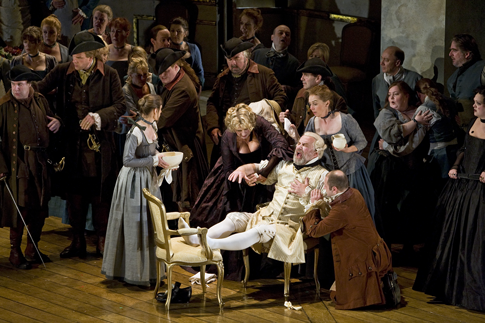 John Tomlinson (Baron Ochs) centre group
John Tomlinson (Baron Ochs) centre group
Rosenkavalier was, of course, Strauss’s answer to Figaro, and director David McVicar’s 2005 staging of Mozart’s work for the Royal Opera clearly took much inspiration from this production which originated at Scottish Opera in 1999. At times this Rosenkavalier seems full of McVicar clichés, but as it predates most of the work for which he’s now renowned, it should rightly be seen as an original. One such ‘cliché’ was the deconstructed rococo set, a single one used (with contrasting embellishments) for all three acts. Another, repeated in Figaro, was the attention to detail in the direction of a multitude of minor roles, servants, and non-singing characters. Harry Ward’s idiotic, mugging Leopold stood out, but from the Singer (Alfie Boe, replacing an indisposed Dwayne Jones) to the Milliner, all were clearly defined and full of personality. Stuart Kale’s Valzacchi was partnered by an exceptional Annina in Madeleine Shaw, currently on ENO’s Young Singers programme.
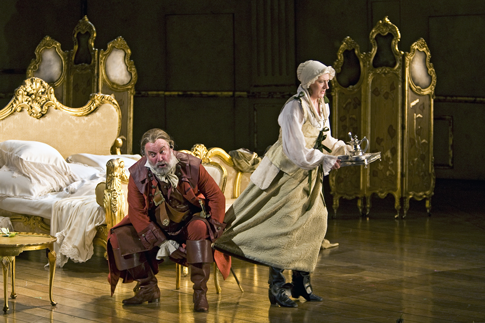 John Tomlinson (Baron Ochs) / Sarah Connolly (Octavian as ‘Mariandel’)
John Tomlinson (Baron Ochs) / Sarah Connolly (Octavian as ‘Mariandel’)
Sometimes, the concentration on detail is to the detriment of the bigger moments. The Marschallin’s exit after the trio is unsympathetically staged, with Janice Watson forced to edge her way clumsily through a side doorway that is too small for her immense dress, and lacks impact. Ed Gardner’s conducting, though sumptuous when required, is fairly conservative and supports rather than adds to the intricate character of the performance. But McVicar’s ability to make this lengthy and variably-paced opera flow so well — even with standard musical cuts opened out — is a credit to his dramatic intelligence.
Ruth Elleson © 2008
image=http://www.operatoday.com/Rosenkavalier_ENO_01.png image_description=Sarah Tynan (Sophie) / Sarah Connolly (Octavian) [Photo © Clive Barda / ENO] product=yes product_title=Richard Strauss: Der RosenKavalierEnglish National Opera, London Coliseum, performance of 24 May product_by=The Feldmarschallin (Janice Watson); Octavian (Sarah Connolly); Baron Ochs (John Tomlinson); Sophie (Sarah Tynan); Herr von Faninal (Andrew Shore); Annina (Madeleine Shaw); Valzacchi (Stuart Kale); Duenna (Janice Cairns); Singer (Dwayne Jones); Police Commissar (Nicholas Folwell); Notary (James Gower). Conductor Edward Gardner; Director/Designer David McVicar; Associate Set Designer Michael Vale; Costume Designer Tanya McCallin; Original Lighting Designer Paule Constable; Translation Alfred Kalisch product_id=Above: Sarah Tynan (Sophie) / Sarah Connolly (Octavian)
All photos © Clive Barda / ENO
Il Matrimonio Segreto in Brooklyn
The piece is obscure enough to be news (outside music schools, it’s rarely given more than once in twenty years). None of its arias or ensembles are especially well known (or worthy of that distinction), but all are pleasant enough to pass the time, and the whole piece is so sprightly that at the world premiere, after a celebratory banquet, the emperor said, “Sing me an encore. In fact, do the whole piece again” — and they did. (This is the same emperor who hadn’t much cared for Clemenza di Tito a few months before.)
Myself, still unable to hum any of Matrimonio after four exposures over the years, I’d prefer a bolder choice: Paisiello, Martin y Soler, Salieri, Simone Mayr. They all wrote light operas (and not so light operas) for the same discriminating audience as Mozart and Cimarosa, and their works, famous then, are far less well known today. I’ve heard several, all worthy. Too, like Cimarosa, they tell us interesting things about why Mozart stands out from the pack, and where Rossini and the future of Italian opera came from.
Matrimonio Segreto is a cross between the buffo tradition (its characters are traditional commedia dell’ arte figures) and the comedy of manners — the libretto was derived from Garrick’s play The Clandestine Marriage. When, in Jonathan Miller’s production (devised for Glyndebourne in 1992, but cheap to revive), Colin Coad as Girolamo, with his buffo belly, confronts Simon Best as Lord Robinson, with his aristocratic English slouch, we know just where we are: that feature of both genres, two pompous fellows fiercely at cross purposes. Mozart had set such moments; Rossini and Donizetti would make capital of them as well. Money, honor, snobbery and love contend for victory, and honor gets the worst of it, as usual. That might be the difference between tragedy and comedy: in the former, affronts to honor end in bloodshed; in the latter, they produce laughter. Only a genius like Mozart could mix these genres and produce delight.
Miller’s production has the virtue of simplicity — taken to excess, in that a unit set (in a highly unattractive color for the residence of a wealthy man hoping to catch a noble son-in-law) does not really serve the plot’s situations well. Miller has chosen to go for knockabout comedy (lustful lady jokes, burp jokes) at the expense of other considerations, and far too much of the laughter was due to the excessive colloquialism of the surtitles — but the purpose is to entertain, and the time goes swiftly. (I did enjoy the moment — at the height of the plot’s confusion, with all the characters yelling at once — when the English milord peeped up at the titles to find out what on earth was going on.)
In brief: A wealthy old merchant, Girolamo, has two daughters; his secretary, Paolino, hopes to arrange an aristocratic marriage for the elder, snobby Elisetta, so that the old man will be pleased enough to approve Paolino’s marriage to the younger, pretty Carolina — which marriage has already taken place, secretly. But when Lord Robinson arrives, he falls for Carolina himself and refuses to take Elisetta, even offering to forgo a dowry. Adding to the confusion, Girolamo’s rich, widowed sister, Fidalma, has a thing for Paolino. The confusion is somehow drawn out for two melodious acts (you can see just where Desi and Lucy would put the commercials), whereupon Lord R, checking the surtitles, declares he so loves Carolina that, to ensure her happiness, he will marry her sister. As you can see: many opportunities for duets and trios at cross-purposes are present. But Rossini had not yet invented the grand buffo concertato, so Cimarosa’s scenes do not conclude with those satisfying explosions of mutual confusion and recrimination that seem so typically buffo to us.
The experienced but little known cast of the BAM performances gave pleasure as both singers and actors. Heidi Stober’s was the only name familiar to me — her sweet soprano (and face and figure) were all that a Carolina requires, but her voice also has a velvet, caressing quality that could take her places. Georgia Jarman sang the more bravura role of Elisetta, whose jilted hopes produce flights of parody-heroic coloratura in the manner of Donna Elvira. The voice is pretty, the flounces effective, but her ornamentation was not as precise as I’d have liked. Fredrika Brillembourg sang the thankless part of Aunt Fidalma, but her attractive and easy mezzo and stately figure suggest she would be impressive as Handel’s Cornelia or Mozart’s Sesto.
The comedians — whose lengthy resumes suggest long but insular careers — expertly inhabited the pretensions and asininities required of buffo clowns. Coad’s Girolamo, a father only a buffo heroine could love (and no one could obey), bristled and strutted and held down the bass line. Jonathan Best seemed — appropriately for an English milord in an Italian opera — to have strayed out of his natural element, tossing bits of stage Brit slang into the recitative and even the duets, and staring about the theater bemused as if he couldn’t imagine where he was. His Briticisms were well received, as was the sheer fun he seemed to be having, whether he was flirting with the right girl or the wrong. Chad A. Johnson, the Paolino, listed quite an array of lead roles in his program bio, but his wispy tenor did not seem worthy of any of them. Happily his role is the least important in the opera, and he may have been suffering from the pollen-ridden atmosphere.
Paul Goodwin got a pick-up bunch of musicians from the Brooklyn Philharmonic into unflaggingly lively shape for a pit band. The only awkwardness came from the timpani, off pitch and far too assertive (had there been no time to test balances in the tiny Harvey Theater?) during the opera’s delicious overture. This was most regrettable but, happily, the drums are not heard again after the curtain rises: they proclaim a portentous evening and then do not take part in it.
John Yohalem
image=http://www.operatoday.com/Domenico_Cimarosa.png image_description=Domenico Cimarosa product=yes product_title=Domenico Cimarosa: Il Matrimonio SegretoBAM (Brooklyn Academy of Music) Harvey Theater, performance of May 30. product_by=Carolina: Heidi Stober, Elisetta: Georgia Jarman, Fidalma: Fredrika Brillembourg, Paolino: Chad A. Johnson, Il conte Robinson: Jonathan Best, Geronimo: Conal Coad. Members of the Brooklyn Philharmonic conducted by Paul Goodwin. Directed by Jonathan Miller.
Handel's Rodrigo — Ensemble San Felice, St John’s Smith Square, London
It was extensively revised between the completion of the autograph score and its 1707 première in Florence, and large sections of both versions were subsequently lost. It would appear that the revisions for the Florence production were to the detriment of the piece, and thanks to the discovery in 1983 of a substantial amount of lost material from the autograph (as well as a certain amount of editorial license to recreate missing recitatives, and the loan of a couple of numbers from Handel’s other operas) Alan Curtis’s performing edition — given here in London by a Florentine ensemble as part of the Lufthansa Baroque Festival — is based on Handel’s original intentions.
The story is loosely based on that of an actual 8th-century Spanish king and conqueror, whose political victories were complicated by his apparent inability to be faithful to his wife. In the libretto (by Silvani, and originally set a few years earlier by Marc’Antonio Ziani) Rodrigo has seduced the impressionable young Florinda with the promise of a throne, consequently fathered her a child, and then reneged on his offer. She is left furious, disgraced and bent on revenge, while Rodrigo goes back to his rightful queen, the saintly but childless Esilena, who understandably is deeply distressed by the whole situation. Esilena’s constancy in the face of marital wrongdoing is, in the end, the salvation of all concerned (along with a convenient eleventh-hour plot development whereby Florinda gets a better offer and gives Rodrigo up for good).
Acts 2 and 3 contain some interesting and original numbers — a lovely lute serenade for the soprano secondo uomo, Evanco, and a fragment of a tenor aria (for Giuliano, Florinda’s brother) with a quirky bassoon obbligato, which is cut off by an advance in the plot just as it reaches the B section. The same cannot be said for the first act, where nearly every aria is one of anger, vengeance or war — each individual aria certainly gives the singer scope to demonstrate mettlesome coloratura technique, but an entire act full of identical numbers is rather tiresome, especially when there’s little variety in tessitura (the lowest voice in the cast being a tenor) and when only a couple of the voices were really worth such extended display.
The finest vocal performer by a long way was the soprano Laura Cherici who sang Esilena; her soft-grained tone had a liquid beauty which portrayed the wronged queen ideally, and her one fast aria was sung with exceptional flare. In the title role, the mezzo Gloria Banditelli was disappointing — her singing was accurate and attractive, but it was not a heroic voice. Here in London we are so blessed with regular access to good heroic Handelian mezzos that I fear we take them for granted.
Other than that, not a great deal of the singing was to be recommended; Annamaria dell’Oste’s Florinda was impressive in her agility and force of delivery, but she had a tendency to go sharp. In fact, there were intonation problems from the majority, and the contralto Caterina Calvi (in the virtually unnecessary role of Fernando) sounded as though she should have been at home with laryngitis, though no announcement was made to this effect. There was some exceptionally fine instrumental playing, however — especially from the continuo cellist and lutenist. Federico Bardazzi was the conductor.
Though Luciano Alberti’s semi-staging — against a backdrop of projected line-drawings of the original 1707 production — was fairly rudimentary, a fair amount of (dare I say somewhat misplaced) effort had obviously been made with Enrico Coveri Maison’s costume designs, which attempted to replicate the styles and shapes shown in the projected images. They were a typically early-18th-century take on costumes for an opera set in the 8th century, but coloured in a lurid array of much more modern cerises, turquoises and oranges.
Ruth Elleson © 2008
image=http://www.operatoday.com/Banditelli-Gloria.png image_description=Gloria Banditelli product=yes product_title=G. F. Handel: Rodrigo product_by=Gloria Banditelli (Rodrigo), Laura Cherici (Esilena), Annamaria dell’Oste (Florinda), Leonardo De Lisi (Giuliano), Susanna Ricci (Evanco), Caterina Calvi (Fernando), Ensemble San Felice, Federico Bardazzi (cond.) product_id=Above: Gloria BanditelliIl Trovatore not dampened by weather
 By Fiona Maddocks [Evening Standard, 4 June 2008]
By Fiona Maddocks [Evening Standard, 4 June 2008]
To the accompaniment of storm, tempest and icy blast, Opera Holland Park’s 2008 season opened in roaring style.
Verdi’s Il Trovatore, the one about the gipsy who carelessly throws a baby on the fire and causes a good deal of operatic trouble, is a long evening with your feet wet. It’s a tribute to all involved that it felt shorter than this most convoluted of tales sometimes can, even in lavish circumstances.
Jean-François Lapointe From Europe and Back
 Wah Keung Chan [La Scena Musicale, 4 June 2008]
Wah Keung Chan [La Scena Musicale, 4 June 2008]
Canadian baritone Jean-François Lapointe is on a mission. Under his somewhat soft-spoken exterior is an artist passionate about protecting (in French he uses the verb défendre often) his artistic culture.
Baritone excited about new-look 'Das Rheingold'
 (Photo by Terrence McCarthy courtesy of San Francisco Opera)
(Photo by Terrence McCarthy courtesy of San Francisco Opera)
By Sue Gilmore [Mercury News, 3 June 2008]
Look out, opera lovers. A new interpretation of Richard Wagner's "Ring" cycle is on the way, and it may make fans wonder what the Valhalla is going on.
Scaling Up for 'Die Soldaten'
 By KATE TAYLOR [NY Sun, 2 June 2008]
By KATE TAYLOR [NY Sun, 2 June 2008]
The opera "Die Soldaten," written in 1965 by the German composer Bernd Alois Zimmermann, is nearly impossible to perform. With its huge orchestra, its intensely difficult 12-tone score, and a narrative in which past, present, and future overlap — Zimmermann once imagined it being performed on 12 stages to distinguish the work's times and locales — the piece has intimidated many an artistic director.
June 2, 2008
A Tribute to Franco Zeffirelli
The event, which was free to the public, included an up-close interview with Franco Zeffirelli, performances from his Metropolitan Opera colleagues, and a signing of a limited edition of a hagiographical book about his Met productions as well as other vast memorabilia that documents the career of the award-winning producer and director of opera, theatre, film and television.
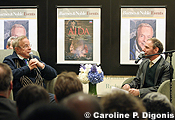
Franco Zeffirelli interviewed by Ira Siff
Franco Zeffirelli entered the reception to a standing ovation from his fans, friends, and colleagues. Among audience attendees was the former General Manager of the Metropolitan Opera, Joseph Volpe, who had a long, successful collaboration with Franco Zeffirelli, at the Met. The press coverage was vast and extended to the Italian news media. Independent film Director Abel Ferrara had his film crew cover the entire event for a documentary he is shooting on Franco Zeffirelli. Then the fabulous voices of the Metropolitan Opera house came, both old and new. Aprile Millo was the gracious hostess and a longtime friend of Franco Zeffirelli, with whom she had many memorable performances with at the Metropolitan Opera house.
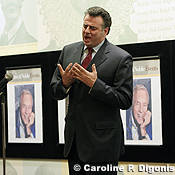 Marcello Giordani performing Nessun Dorma from Turandot.
Marcello Giordani performing Nessun Dorma from Turandot.
Marcello Giordani performed the aria Nessun Dorma magnificently, dedicated to both Franco Zeffirelli and to the late Luciano Pavarotti. Later, Marcello Giordani joined Aprile Millo for the love duet from Act I of Tosca. Their voices were golden and clearly gave flight to Franco Zeffirelli’s visions of opera. Baritone Mark Delavan performed as well to the delight of the audience. The performances were followed by an interview with Ira Siff. Franco Zeffirelli, as he settled into the sage green chair that awaited him, spoke fondly of intriguing memories and kept the audience captivated in the style of all Zeffirelli productions.
Diane Malone © 2008
All photos: © Caroline P. Digonis 2008.
[Reprinted by permission of the author from Metroway — The Online Guide to Everything New York.]
 Aprile Millo and Marcello Giordani
performing from Tosca.
Aprile Millo and Marcello Giordani
performing from Tosca.
Photo © Caroline P. Digonis
June 1, 2008
MOZART: La Clemenza di Tito — Covent Garden 1976
Music composed by W. A. Mozart. Libretto by Pietro Metastasio, adapted by Caterino Mazzolà.
First Performance: 6 September 1791, National Theatre, Prague.
| Principal characters: | |
| Tito [Titus Flavius Vespasianus], Roman Emperor | Tenor |
| Vitellia, daughter of the deposed Emperor Vitellius | Soprano |
| Servilia, sister of Sextus, in love with Annius | Soprano |
| Sesto [Sextus], friend of Titus, in love with Vitellia | Soprano |
| Annio [Annius], friend of Sextus, in love with Servilia | Soprano |
| Publio [Publius], prefect of the praetorian guard | Bass |
Setting: Rome, c. 80 C.E.
Synopsis:
Act I
Scene 1. Vitellia's apartments
Vitellia, daughter of a previous emperor of Rome, who had hoped in vain to marry the Emperor Tito (Titus), incites Sesto (Sextus) to prove his love for her by killing Tito, despite the fact that he is a friend.
Annio (Annius), a friend of Sesto, brings him a summons from the emperor. Vitellia makes an insulting remark about Tito's love for the Jewish Queen Berenice, only to learn that Tito has parted from her and sent her back home. With renewed hopes of becoming empress, she tells Sesto to defer his assassination plans, giving him no reason, demanding that he trust her. Sesto consents with delight when Annio asks for the hand of his sister Servilia.
Scene 2. The Roman Forum
The people acclaim Tito. He calls Sesto and Annio to him and asks Sesto for the hand of Servilia. Both are taken aback, but Annio collects himself sufficiently to congratulate the emperor on his choice, and is given the task of conveying the news to Servilia.
Tito keeps Sesto at his side, remarking that the joy of rewarding friends is the only pleasure he derives from his position. Annio laments the loss of Servilia and when he tells her of her fate, she also grieves for their lost happiness.
Scene 3. The imperial palace on the Palatine Hill
Publio, commander of the Praetorian guard, brings Tito a list of those who have defamed him and his predecessors. Tito deplores the investigation which has produced the list and forgives those named on it.
Servilia confesses to the emperor that she loves Annio, but agrees to marry him if he still wishes. He releases her from any obligation to him, while wishing that all around him were as frank as she. Vitellia greets Servilia ironically as future empress and beloved of Tito, but Servilia answers cryptically that Vitellia may still be able to marry him. Not understanding, Vitellia rages at having first Berenice, then Servilia prefered to her, and threatens vengeance. She stirs up Sesto again and he promises to avenge her, but when Publio brings the news that Tito has now chosen her as his wife, she regrets the haste with which she sent Sesto off.
Scene 4. The square before the Capitol
Sesto, torn between love and friendship, resolves to die rather than betray his friend, but his plot is already under way and the Capitol is burning. Feeling that he is now committed, he enters the Capitol in search of Tito. A crowd gathers and Sesto appears, announcing the assassination of the emperor. Vitellia warns him not to betray himself.
Act II
Scene 1. The square before the Capitol
Sesto has learnt that he stabbed another man in mistake for Tito. He confesses his attempted crime to Annio, declaring that he will leave Rome as a repentant exile. But he is not yet suspected, and Annio advises that he should continue to serve the emperor and by his fidelity atone for his crime.
But Vitellia counsels him to leave at once, fearing not only for his life, but for her honor as the instigator of the attempt. Sesto swears that her secret is safe with him.
He is arrested by Publio, as the man he had stabbed had not died and had been able to reveal the identity of his attacker. Sesto is led off to be tried by the Senate, leaving Vitellia a prey to remorse.
Scene 2. A great hall
The people rejoice in the safety of Tito and he expresses his gratitude for their devotion. He asks Publio about the progress of the proceedings against Sesto, trying to find excuses for his friend, but Publio can give him no comfort.
Annio begs for mercy for Sesto, but is interrupted by Publio, bringing news of the condemnation of Sesto, who is to be thrown to the beasts in the arena. He hands Tito the death warrant to sign, but the emperor, torn between justice and mercy, decides to hear Sesto before signing. He offers Sesto the chance to exculpate himself, but his lips are sealed by his promise to Vitellia and he says that he deserves and desires death.
Servilia and Annio beg Vitellia, as their future empress, to intercede for Sesto, reproving her when she seems to hesitate. Vitellia is moved to admiration by the steadfastness of Sesto, examines her conscience and resolves to confess, even though it will cost her the throne she has sought and may even mean her death.
Scene 3. The Amphitheatre
The people have gathered for the games in which Sesto is to die. Vitellia confesses, explaining that she had misconstrued Tito's customary affability into expressions of affection and felt spurned when he seemed to choose others instead of her. In the face of so much treachery, Tito decides to be magnanimous, to forgive and forget.
[Synopsis Source: Opera~Opera]
Click here for the complete libretto.
Click here for an analysis of La Clemenza di Tito as propaganda.
image=http://www.operatoday.com/Titus_draped_bust_cropped.png image_description=Titus Flavius Vespasianus audio=yes first_audio_name=W. A. Mozart: La Clemenza di Tito first_audio_link=http://www.operatoday.com/Clemenza2.m3u product=yes product_title=W. A. Mozart: La Clemenza di Tito product_by=Werner Hollweg (Tito)Yvonne Minton (Sesto)
Janet Baker (Vitellia)
Teresa Cahill (Servilia)
Anne Howells (Annio)
Robert Lloyd (Publio)
Orchestra and Chorus of the Royal Opera House
John Pritchard (cond.)
Live performance: c. February 1976, Covent Garden, London